#(edited the post to break up the text a bit for readability)
Text
maurice (the book, the movie which is pretty close to the book all things considered, etc) has a lot of problems like fundamentally it's definitely a product of its time and of the man (e.m forster) who wrote it and the state of the british empire and culture in his lifetime, his biases and failings of his ideology are clear when reading his writing.
but there really is something so endlessly fascinating to me about it Because of that, if that makes sense, because it really does capture the mindset of an Edwardian era middle class white British man and all that entails, and how the quintessential version of that man might react when faced with his desire for men and only men, and the ways in which that might very realistically be experienced and expressed.
this is especially notable because he wrote it privately, knowing he couldn't publish it until after he died or until some distant day when british culture could cope with a book like that, and so many of the characters are inspired by himself and the other white British gay men he knew from all walks of life and it's sort of just written for them and so it feels very personal and insightful to that entire mindset and experience of the time. like it functions as such an excellent snapshot of that time and place and group of people and it's simultaneously a work of complete fantasy and the overwhelming whiteness and britishness of it and the very premise (as well as the solution offered by it) is something entirely a product of itself, if that makes sense, like this book only could have been written in these conditions and in this context.
analysing it feels like placing an entire worldview and experience in a fish tank and spinning it around - noticing what it says and what it doesn't, what is left out, how events are framed, the thesis of the story, the entire thing is fascinating no matter what angle you take and it's so self indulgent and confessional it's just the whole thing laid bare in a way that is really rare imo
especially w the emphasis on class in particular as a defining thing in the story, like maurice is fundamentally an exploration of class and forster tries to grapple with these things clumsily and using the only language and approach he knows how to because of the circumstances of his own life, and you can see the limits of his understanding of class dynamics through the book, the fault lines in his thinking and his contradictory opinions on working class people and old money gentry and the middle class and all of that. like it's Not a marxist look at class whatsoever but I always find things like that really fascinating because they're trying to grapple with class consciousness and they're so close and yet so far and in maurice it's wrapped up in anxieties about white male masculinity and british propriety and the specific strange brand of late victoria /edwardian period misogyny and you get the benefits and consequences of empire and british racism laid bare on a kind of deeply insular, commonplace level without ever once mentioning let alone featuring a nonwhite person at all. like the Lack of mention of these things feeds into the fantasy aspect of it and the self indulgence of it.
bc at it's core it's just all so loud and it's an edwardian era white cis gay affluent british mans fantasy of his ideal man and ideal relationship and that fantasy of escaping class society to some """"primitive"""" state where they can just Be but there's no room for that within the british empire and it's so so so so indulgent in that way and so revealing. theres so much to unpack and so much that still feels relevant to the experience of white middle class gay people in the imperial core today and their mindset and anxieties and the whole thing is just endlessly interesting to me in a "I want to study this in a laboratory" way. like it's the kind of book that makes me want to do a marxist analysis of the entire ideology on display here and how it's still relevant to current class anxieties and fantasies of escapism within certain communities - like the cottagecore thing - and pick it apart and examine its innards because it reveals so much at just a rudimentary level and whenever I reread it there's something new I think about and come away with
#its one of the books i always go back to like i know the whole thing nearly by heart at this point#because its just endlessly fascinating to dissect and every time i listen to it/read it i come away with something different#and its a pretty short book so its easy to do#(edited the post to break up the text a bit for readability)
77 notes
·
View notes
Note
35 and 79 for the writing asks!
Thank you for asking! Here's the ask list!
35- What's your favorite fic you've posted?
That's kind of a tricky one, purely thanks to the number of fics I've posted (I have 122 stories on Ao3, there's a lot to choose from!). I have quite a few favorites, but the top spot is a hard 3-way tie.
Chaos is Normal (For Us, at Least) is my baby, currently my longest complete fic and currently has the most hits out of any of my works (nearly 2,300 hits currently, which boggles my mind). I managed to write the whole thing in about a month, and I'm just so proud of how it turned out. It has quite a few firsts in it for me as a writer, the biggest of which were my first "proper" fight scenes that actually felt good.
Spring Cleaning is a much shorter story, but it's still up there among my favorites. I like writing action and fights, but I love character-focused moments like what's in this story. Moments where characters get to just reflect on what led them to their current place in life are weirdly fun for me.
Finally, Before They Were... is one of my most recent stories, but I absolutely love it. I got to write some pretty ominous lines in this one which is always a fun time, as is building tension through the scene (especially evident in the first chapter). Getting to explore character backstories that are as open as the ones in I Expect You to Die is a lot of fun; we have some information, but not a whole lot, and I enjoy getting to find ways to plug established information into the story. I also got to do some interesting research for this one, since the first chapter takes place in the 1940s, an era I haven't really written in until now. I also got to look into the history of spy fiction for the second chapter, which was pretty neat!
79- Do you have any writing advice you want to share?
There's a couple of things, I guess, though they're likely the sort of "standard" bits everyone tends to hear.
Write what you like, first of all; you can kind of tell when the author isn't actually interested in what they're writing, and it tends to result in a final product that neither party (author or reader) is entirely pleased with, at least in my experience and view of things.
Basic formatting goes a long way in making your writing more enjoyable! Knowing where to put paragraph breaks, punctuation basics and the like help so much. It doesn't have to be perfect (hell knows my punctuation can get a little weird), but this stuff is important for readability on part of the reader and the author. It's way easier to backtrack in order to insert scenes or tweak things when you aren't looking at a solid wall of text.
In a similar vein, proofreading and spell check are your friends. They're not perfect (I've found various typos in my own works years after posting them-), but again, it does help readability and can improve your skills over time.
Finally, if you're writing, read. Read other fics, yeah, but try to have "official" publications in your rotation, too. Those books have gone through editing that's likely far more intense than anything that'd be expected of a fic, they can be extremely helpful if you find yourself stuck trying to format things, and you can find inspiration in them that you might not find in other fics.
1 note
·
View note
Text
How Proofreading and Editing Can Help Improve Communication
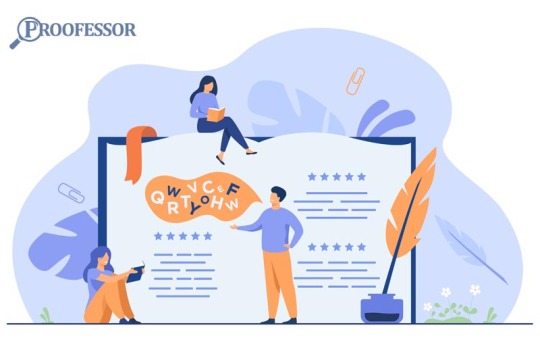
The key aspect of writing is sharing a message. All writers put pen to paper because they have something to say, which means editing services and proofreading services have a crucial role to play in sharing this information.
It also means that editing services and proofreading services are required to check over numerous aspects of the content. These areas range from superficial elements, such as spelling, grammar and punctuation, to more intrinsic parts, such as rewriting or restructuring the material or playing the role of the audience to identify areas for improvement.
Here are some of the principal area editors will review to ensure content makes meaningful, clear, concise points:
● Tone of voice
● Titles and headings
Tone of voice
Usually, the audience will dictate what tone a piece of writing has. If, for example, a writer is presenting a weighty academic manuscript about the intricacies of gully erosion in Malawi, the tone will most likely be more formal and detached than a blog post about the best backpacking destinations in the same country. It’s the difference between, ‘Hey guys, check this out,’ and, ‘This study will focus on proving the hypothesis correct’.
Distance and detachment, are the lack thereof, are therefore important. When a writer wants to communicate directly with the audience and engage their enthusiasm, the tone of voice will be more-lively, and personal. This means that the content will include more first-person pronouns, a conversational voice (‘you guys’ is a recurring phrase deployed by bloggers, for instance) and perhaps a bit of slang.
More academic work, meanwhile, will have a sterner, more detached feel. The intent is to create a sense of gravitas: writers present themselves as authorities, and their tone should reflect that. Thus, editing services and proofreading services will remove first-person pronouns and use more academic terms.
In short, editors will ensure that the content uses an appropriate tone.
Formatting
Making their work presentable is an integral skill for writers. Editing services and proofreading services can certainly help by working with the material to refine and streamline it.
Again, the focus is clear communication: by creating content that is nicely spaced, full of digestible content and demonstrates a clear thematic progression, writers and editors go a long way to making the document accessible, and capable of ensnaring the reader.
This goal can be achieved by breaking the content into marked sections with a clear focus. Chapter breaks, shorter sentences, readable paragraphs, obvious themes and suitable titles and headings: all these and more will give the reader an ‘in’ and allow them to quickly understand the writer’s point.
Editing services and proofreading services will make suitable adjustments to the content’s structure to support the writer, such as suggesting alternatives to unclear headings or phraseology and breaking up the text to help improve the flow.
Readable material plays a crucial role in positioning writers as legitimate authorities in their field, which shows the importance of clear communication.
Read More:
Here’s Why Professional Proofreading and Editing Services Can Help Writers
Key Areas Where Editors Can Help Improve Writing
0 notes
Note
Do you have any advice for writing? I'm finding it so hard to write today. I've got half finished fics everywhere but I can't commit to finishing any and whatever I do end up writing I end yp hating and I've written something that i really like but its SO similar to another fic I've written that I can't stomach it and so I want to use pieces of it for something else but I don't know how to and ugh today :(
oof i feel you babe. sometimes it's hard to write- like you try and things just don't sound right, or the words just don't come to you. super frustrating, happens to me all the time
i have two solutions that usually work for me: reading and word-vomiting. whenever i get really stuck and gate what i'm writing, i like to take a break and go read other stuff- whether that's other fanfics or books or magazine articles or whatever. seeing how other people write helps me think about my own writing and especially with fanfic, reading other stories about our beloved blorbos helps me better envision how i want to write them.
and when that fails, i just open up a blank word document or text post, and i just. word vomit. i type whatever comes to mind just to get it out there- bits of dialogue, a single descriptive line i really like, little notes to myself like "okay and then they kiss and it's great so moving on". i go in knowing it's not going to be pretty and it's not going to make sense, but i feel productive because i at least got the thoughts out of my head. sometimes, i go back and actually fix and edit the word vomit mess into something readable that i like. other times i just go in and delete it.
hopefully this helps babe <3
#ask#anon#also!!! nothing wrong with writing similar things#people are going to love it no matter what <3
2 notes
·
View notes
Text
I bought a typewriter!
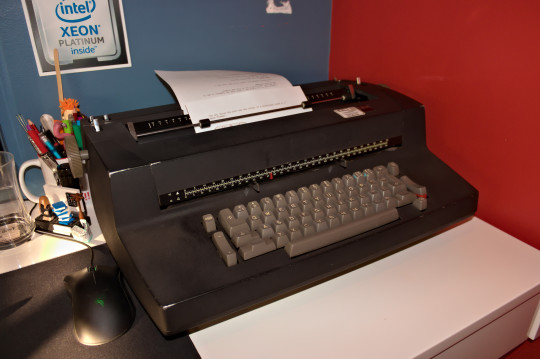
Now you might be thinking many things about this like “Well that seems excessive” and “hey Kali aren’t you a Computers Dipshit” and the answer to both of those is yes.
There’s another two posts in me about this, one about why this typewriter in particular is such an interesting piece of cultural history, and another about how it works and why it’s Like This. This post is about neither of those interesting things and instead about me showing off the cool new thing I got and explaining why I wanted it.

One of the old boxes of ribbon cartridges that came with this. Manufactured 1984. Graphic design truly is my passion.
Alright breakdown of what I got:
1976 IBM Selectric II Typewriter (with Courier 12-pitch typing element)
An original Vinyl cover for the machine
Three additional typing elements (in Orator, Artisan and Diplomat)
The original manual
Two large boxes of ancient ribbon cartridges.
A bag full of correction reels
A few pads of correction film
An antique toothbrush for cleaning the elements
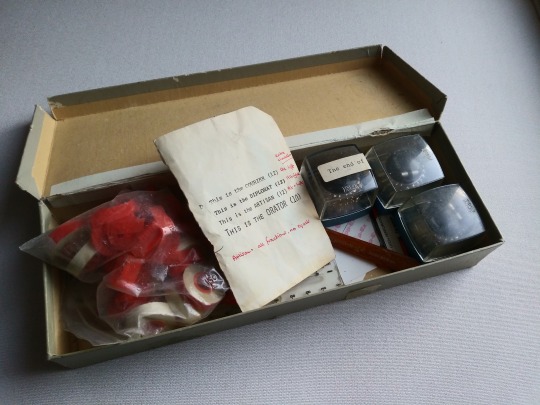
A box of accessories that came with the typewriter: Correction tape, typeballs, correction films, three typeballs, some fontface samples on an old envelope, and a toothbrush.
This is an old working machine, not a showpiece. In fact, it was in use right up until the day I bought it and I fully intend to keep using it for as long as I can. This thing is 44 years old, also known as twice my age, and I’ll be damned if I’m going to be the one who breaks it.
I bought it for ZAR 1200 (about USD 70) from a woman who deals in imported wines, she used it to fill in shipping forms. She has several other typewriters and has been slowly selling them off so I don’t feel bad about this. She’d had it since the 80′s. USD 70 is an absolute song for a working Selectric, they usually go for at least double that without any accessories, but no one is buying typewriters around these parts.

The original manual, dated 1978.
I’ve wanted a typewriter for a little while now, because I wanted a writing tool that produces physical artifacts quickly and immediately. I’m very avidly aware that while I write more than I ever have (mostly Tumblr posts) these days, they’re all very ephemeral. They will not outlive Tumblr, and they certainly will not outlive me. Carbon black on paper is much more long lived, typewritten texts are still readable over a century later in many cases. MySpace accidentally deleted everything that happened on their site before 2013. You decide which one is more sensible.
In addition, this is a nice way for me to produce writing that is too personal for my usual habit of cracking open a Tumblr edit tab. A lot of posts are languishing in my drafts folder after I realised I didn’t actually want to post them online and just needed to get them out of my head. This is mostly intended to take the place of wandering in circles in my room talking to myself.
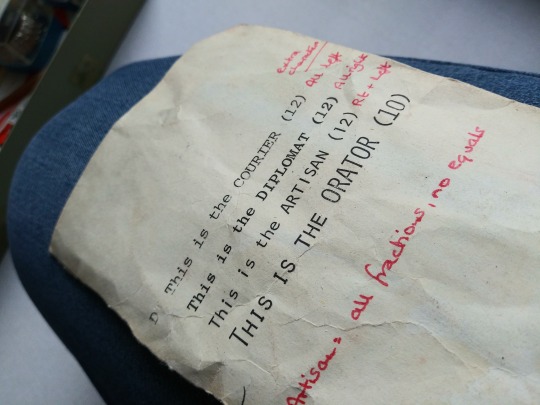
A sample sheet with the four font faces that came with this typewriter
Now you may say that I should just type stuff on a computer, or write out notes longhand. To that I say a) printing is the worst experience one can have on a computer and b) I hate writing by hand. I could never keep diaries as a kid because it involved writing by hand and it sucked, in fact I’m almost certain that I don’t actually know how to write and that I just figure out the shapes of letters new every time I have to do it. I can type extremely naturally, almost at my speed of thought. I will only get better at this. It is also UNBELIEVABLY loud.
I’ll have to talk more about the historical and social legacy of the IBM Selectric and, to a lesser degree, that of typewriters in general in another post, as well as the utter miracle of engineering prowess that is the IBM Selectric. Let’s just say that those were also a big part of why I chose this. It’s a really important piece of history for engineers, computer nerds, typists and secretaries, the last of which is a group to which I have no real claim but I think they’re neat.

A scan of the demo page the last owner wrote for me, showing most of the capabilities of the machine.
This thing is a battleship, it’s in basically perfect condition. The only problems are that the correction tape needs to be replaced and realigned, and the currently installed typeball is stuck on and the release lever isn’t working. These can both be solved without too much trouble, plus there’s a phone number for a repair and servicing place that the previous owner took it to stuck on the outside, so that’s good for me. Yes, there are still places that service these machines as normal business, I was very surprised.
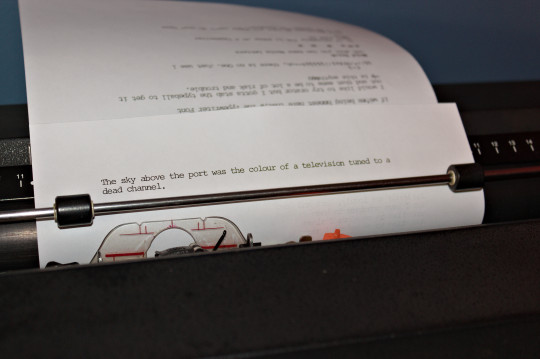
little bit of my own demo text. Did you know William Gibson wrote Neuromancer, that cyberpunk hyperfuturistic work of fiction, on a typewriter? He didn’t own a computer until after it was published.
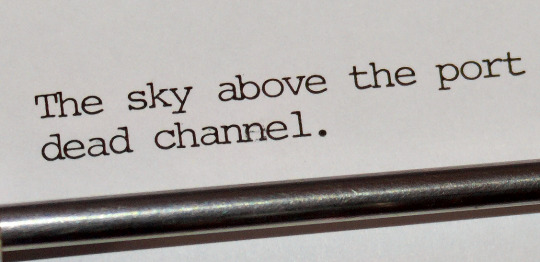
1:1 pixel focus of the text from the above photo. It is a VERY smooth operator. You can see where I corrected an error in the word “channel”.
That’s about all I got for now, this is extremely cool. I’m really enjoying using it.
122 notes
·
View notes
Text
Frog Translations 2: Andrias's Book
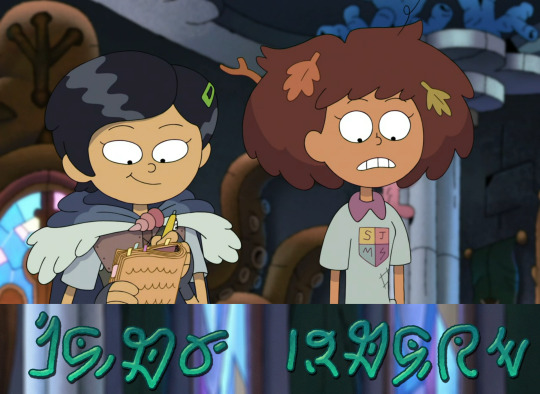
A sort of followup to my other post about translating the Newtopian(?) messages, cause I really like doing stuff like this. The first one wasn't too exciting and was all stuff from the three temples that Marcy read so it was easy to check it after. There isn't a lot of the language outside of the temples, but the last post was huge so I kept it at that. At the end of it I kinda grumbled I couldn't figure out Andrias's book.
So I decided to just go for it and try.
There’s no actual spoilers here, but given the nature of the book and the box and such, it might be considered speculation or foreshadowing?
But first off, I'm just going to repeat the bonus from the first one. In Sleepover, there's a sign Marcy reads as “KEEP OUT” that has a little scribble on the top. Presumably, the Shadowfish are the spooky ghosts?
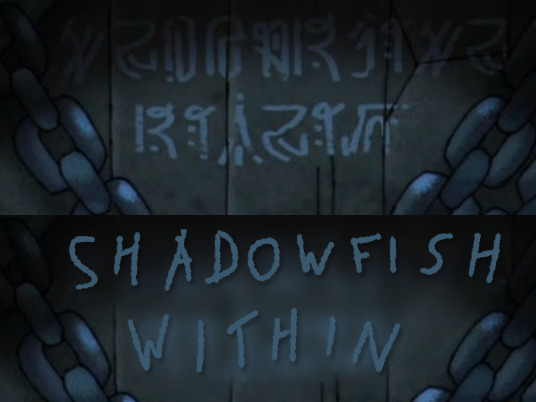
In the same episode, in Marcy's room, she has a thing on the wall that translates to “Newtopia Map” even though it's just the castle. Marcy, you gotta label your stuff correctly smh.
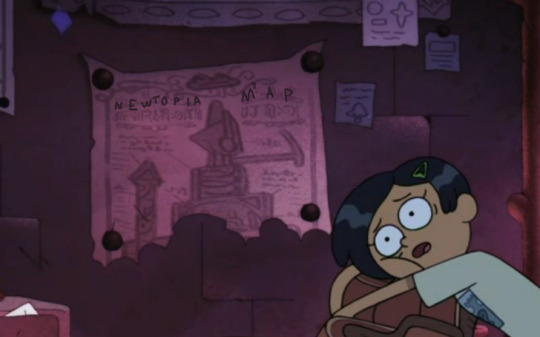
(also that's me after squinting at these pictures and photos forever)
And now the book. To start, I'll go with the obvious; the gems are just the attributes. Of note though is the numbers above the words, cause I don't think they showed up in the temples. Have there been normal numerals anywhere in the show?

(forgive the fanciness in the letters I went a bit overboard)
The title on the second page next to the activated gems is just “STARS”
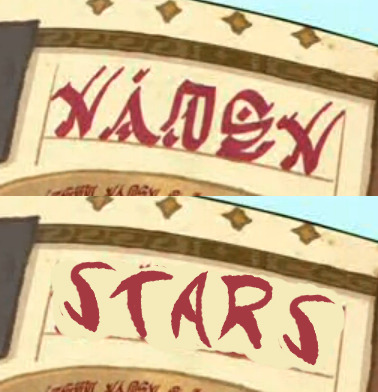
But the text underneath that is where it gets a bit tricky.

I couldn't find a good quality screenshot of it and it's hard to read tiny frog scribbles when they're so blurry, so here's a photo of my TV edited a tad to maybe make it a bit more readable. I’m bad at photos, sorry.

I'm not quite ambitious enough to edit it all nice but after squinting at it and going back and forth a bunch, I think it says the following:
THREE STARS BLAZE ON BRIGHT
COME FROM BEYOND TO EXPEL THE NIGHT
SHOULD THEY FIGHT OR EMBRACE THE FALL
THEIR CHOICE WILL DETERMINE ALL
Details and breakdown below because it’s ugly and frankly, excessive.
Let's start by putting the alphabet here.

When I say I “think” it says the message above it’s because frankly my note looked like this:

It's worth noting that there's weird spaces between some of the letters, so all the words here are assumptions by default.
So let's break it down.

This one's not too bad and seems pretty clear.
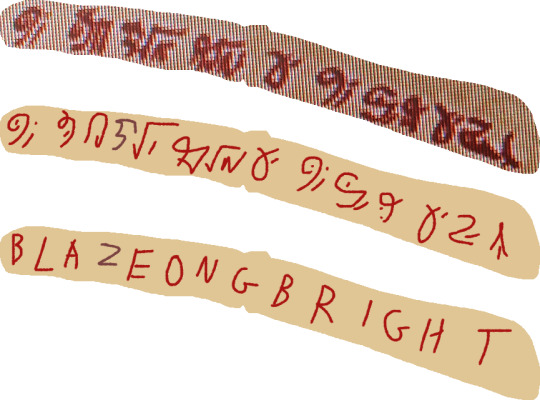
I really don't even know if this one is close at all tbh. I was pretty confident about the B at the start, the “ON G BRI”, and the T at the end, but the rest is all guesses. I assumed “BRIGHT” because of the following line rhyming and “BLAZE/BLAZING/BLAZE ON” because “stars.” The blaze is confusing to me cause the G is there? And like the chart above, I’m not even sure what Z looks like.
The scribbles are how I read it but I'm up for corrections, suggestions or debate cause I'm just baffled.
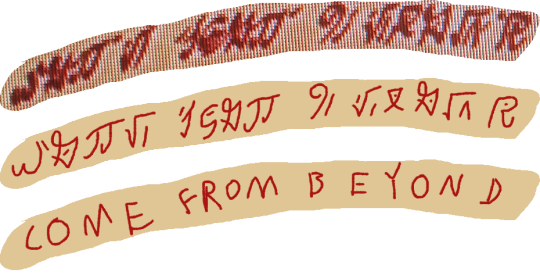
Confident about this.

Also confident. Wanted to note the “X”. It looks a bit fancier than the X from the first temple, but none of the other symbols quite match.
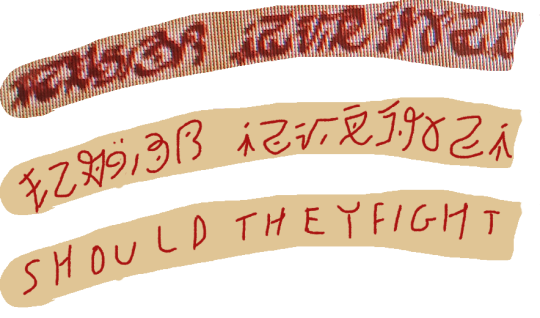
This one took a while cause a lot of the letters are kind of squished together, but I settled on this. The “SH” I'm not sure about but I feel like it's the only word that fits there. The “Y” looks weird. The “FI” is also very squished but they seem distinct enough for me.
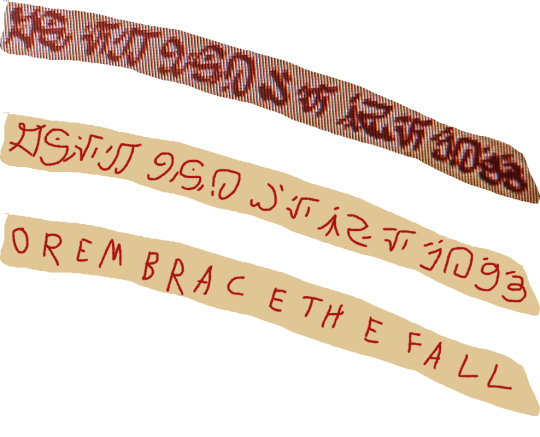
Mostly confident about this. The swirl of the B is weird but I think it's right. The Ls look weird, but I'm sure of FALL given the final line.
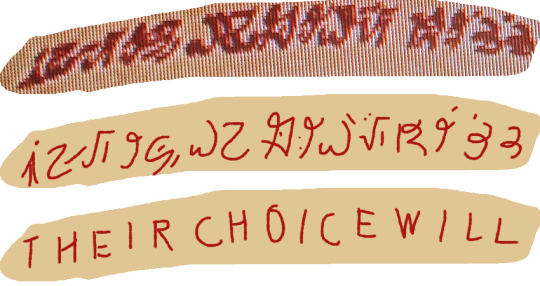
I'm confident about “choice” cause the “C”s are really clear. I built the rest of the word around them. Not sure about the other two words but they make sense to me. I've learned not to trust Ls.

Confident about DETERM. The letters after are squished but I can read it as IN, given the start of the word. The last word has the weird L squiggles, but there are only so many words that can fit in the format of A(?)(?)
Speculation time: with all that out of the way, I'll throw out the easy read that the three girls/energy are probably the “stars” and “embracing the fall” would be powering the gems causing the “Fall” from by Calamity Box.
But I'm not a theory guy, so I'll leave other people for that.
There's also another part of Andrias's book that has scribbles.

You can read the illuminated letters: M in the first, and T in the second. However, I can barely read real English cursive, so I'm not even going to try parsing the frog cursive here. Especially cause after all that above I need a break from looking at frog letters.
If anything isn’t clear, feel free to ask. I’ll gladly try to explain.
I’m bad at conclusions. This was fun. Dunno if someone’s done this before.
Frogs.
#amphibia#I've written more in the past two days than I have in like a year/#and about frog words at that/#i guess this is technically speculation?/
7 notes
·
View notes
Text
Did you know you can add image descriptions directly into the image on tumblr? HTML code has a handy little thing called the “alt” attribute.
This was originally designed to be text that shows up when an image failed to load, so that the user would still know what was meant to be there. This is what a screen reader uses to tell a visually impaired user what an image is about - but it can only provide that information when someone has bothered to add an alt attribute to their image element.
The way of doing it can be a bit impractical - if there is a way to do it in the images of an Image post, I haven’t found it. BUT if you add your image within a post, that’s a different story.
Once your post is all done, you click on the little gear at the top right of your post, then select HTML as the text editor more.
There, each of your images will be represented by an <img> tag. This tag contains the URL of your picture (the src= part), and maybe some height and width attributes.
Within this <img> tag, you can add the alt attribute.
The image tag for my TUA pikachu meme looks like this:

[Imade description: a screenshot of the HTML content of my aforementioned post. The following text is highlighted:
<img src="[a very long URL edited out for better readability]" data-orig-height="784" data-orig-width="1354" alt="shocked pikachu face">
/end ID.]
You can see the alt there at the end.
⚠️ Careful:
The = sign and the quotation marks are really important, don’t forget them
Make sure to put your alt text into the <img> tag, meaning before the final >. This can be a bit tricky as the html has various different tags, so you have to pay attention.
Your alt text should be no longer than 125 characters, so this method will not be suitable for longer image descriptions
DO NOT use special characters such as <> or quotation marks, since those will interfere with the HTML
In general avoid any special characters beyond the alphabet and very basic punctuation to make sure you don’t risk breaking the HTML.
this also means no Emojis!
Basically, this method is most effective with very simple images such as a common, unedited meme, like the shocked pikachu face.
I should also note that this did not originally work when I posted the aforementioned post. The alt simply disappeared. If this happens, just edit the post and add it in again. If you have multiple images, it may be easier to post first without the alt attributes, and then immediately edit the post to add them.
AND ANOTHER THING!
Before adding an image description to someone else’s post, you can check whether they have already added an alt attribute! Right-click on the image and select “Inspect element”. You’ll see the same basic html I screenshotted above, but most often, the alt will only say “image”, meaning no one has added an alt, and tumblr’s post creator has auto filled that in.
Here, practice on these two images of - because I have no imagination - the shocked pikachu. (one of them is mirrored to look right instead of left)


You can see only one of them has a real attribute, while the other was automatically fileld in an just says "image".
As I’ve said, the alt attribute method cannot be used with all images due to constraints of length and character type. But when it’s a very simple, short description, it can be very useful. : )
This post was written for desktop as I almost never use mobile. If you know how to do this on mobile, feel free to add onto this post.
If you have questions about the alt attribute that aren’t covered here, you can find most of your answers via a search engine or on the W3 schools website.
Disclaimer: I am a sighted person, and writing this post based on the fraction of knowledge I have about this topic thanks to writing image descriptions every so often, and knowing a bit of HTML. If you see an issue with this post, please let me know so I can fix it.
#image descriptions#accessibility#long post#okay 3 edits later i hope this post is not broken anymore#can you believe tumblr deleted my bullet point list#thank fuck i copy paster everyhing before hitting post jfc
1 note
·
View note
Note
SHOW US YOUR WROR RAW UNPROCESSED WHOLE GRAIN ORGANIC NOTES
this is going to be a long-ass post i am so sorry to Everyone! i take a lot of notes.
So, as You specifically know (as well as all of my lovely Soggers) I take a LOT of notes. Obsessively. I write fucking everything bc i have very little memory and very much paranoia. This results in literal Piles of notes. Raw planning, on paper, on my phone– doodles of scenes im brainstorming, bulletpoints, entire SCRIPTS– it’s all there but scattered (I’ve got scenes planned in the margins of my goddamn anthropology notes and deciphering it was a NIGHTMARE)
I won’t even upload all the photos of my writing notebook, because itd be like 50 pages of illegible nonesense. but heres a couple of planning phase pages. (may be hard to read, I dropped this notebook both into some tidepools, into a creek on campus, and accidentally leaked my waterbottle onto it in my backpack :/)
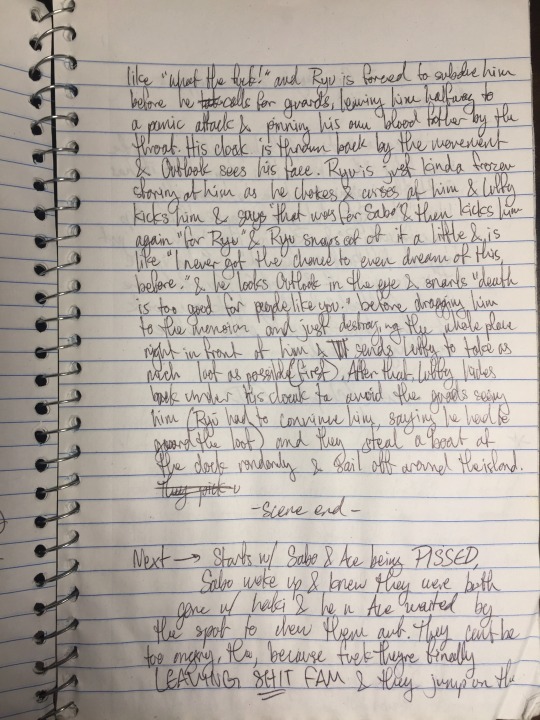
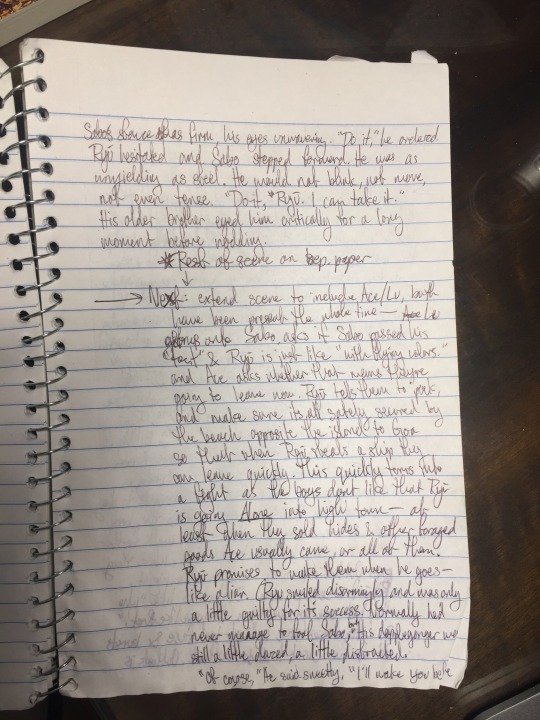
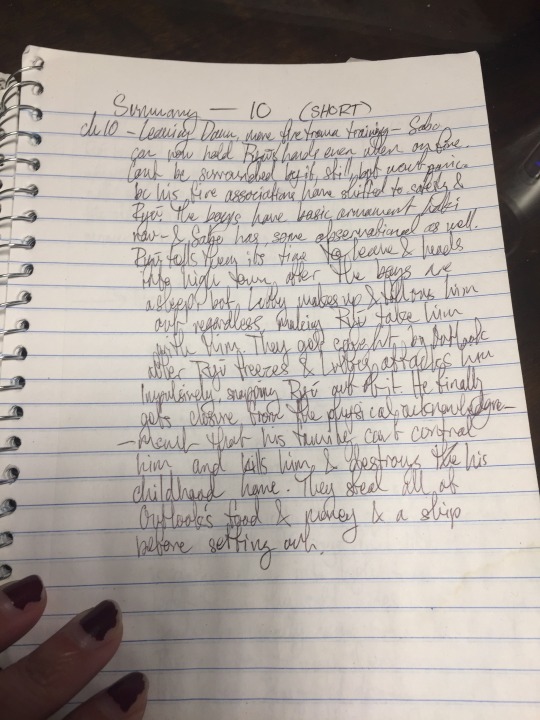
if you can’t tell already, yes they all look exactly like this. Some are even more illegible, because I wrote them with the notebook half under my actual class notes. Because i wrote most of them in class. During lectures. And pretending very badly that i was not doing exactly that. (pay attention in class please i got away with this bc i was filling up elective units)
I’m also flat out MISSING a large portion of my notes bc some of it? isnt even in the damn notebook. its on a sheet of binder paper, or on the empty back of an assignment. I’ve now lost most of those notes, but the ones i do still have are just as (even more, actually) indecipherable chicken scratch:
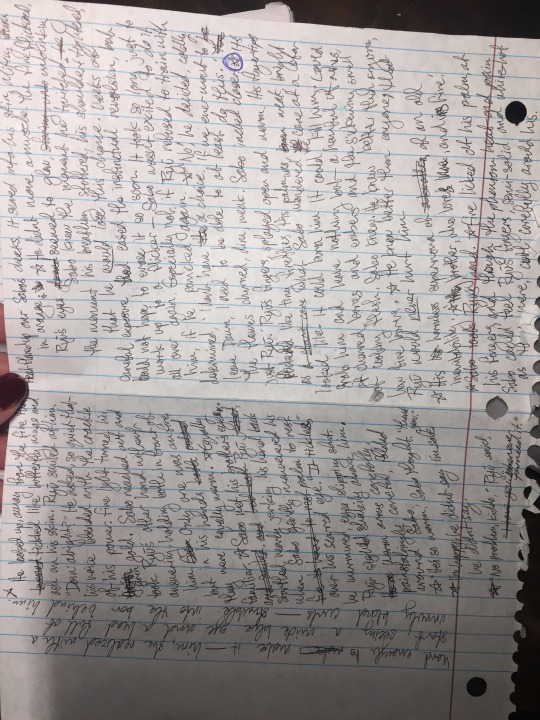
Wow, how clean and tidy and easy to follow! i am in hell.
and this doesnt mention the PAGES and PAGES of outlines that are on my laptop, and the pages of outlined scenes that are on the notes app of my phone. if i put them all, you would have entire chapter spoilers up to the very end of the story so i cant post a lot of them– and also theres just a goddamn lot of them. currently i have 16 pages of outlining. There are no spacing breaks. It is a solid 16 page block of text. Looking at it gives me a migraine.
some assorted notes which i have dredged up from the deleted parts of the main draft google doc go all the way back to when i started Wror in June and they are Barely more readable than my handwriting on sheer account of: articulation is not my strength. These include:
“Ch 8 plan: sabo gets trained specially, awakens his armament haki, beats ace in a bunch of spars and proves himself to be anything but vulnerable. The boys are like “we fucking recognize that technique ryu taught you before us!!” and goad ryu into finally starting them both on basic haki training, just to awaken it, since sabo already has. Also this is the chapter that ace finally confronts ryu for his devil fruit after ryu confirms that some devil fruit users can’t be hurt without haki and ace immediately catches onto that and tries to slam his pipe through ryus head. It doesn’t work, ryu catches the weapon with a haki covered hand, to avoid turning to flame with hit and ace just gets frustrated and accuses ryu of hiding his devil fruit, because he remembers what he saw in grey terminal and that now that he has seen haki he can distinguish it from what he saw and he’s sure no one could do what ryu did. He calls ryu a hypocrite for coddling them even after telling them to stop coddling sabo and ryu has to sit them down and explain that yes he does have powers and he has been hdiing it and explains his reasoning. However instead of understanding th eboys just get fired up and say they don’t wnt to be scared of fire, especially not when it means ryu isn’t taking them seriously in a spar. Ryu finally agrees to start them on desensitization training for fire trauma. Fire desensitization training happens on the beach, so that they have water nearby in case things get out of hand. At some point ace gives ryu a considering look and is just like “if you have a devil fruit that means you can’t swim either right?” and ryu is basically just like “lmao yeah” and then ace immediately attempts to drown him. Lots of murder attempts in ace’s department toget his older brother to be less of an idiot with little success lol(extra: ace tried to attack ryu earlier both to confirm that ryu has a devil fruit that would force him to use haki to hide it, and because he now knows that he CAN’T hurt ryu without haki and as thus can’t beat him and make him admit he’s awake without being good at haki.)” [chapter 8]
“Small sabo lost his hat and goggles in the incident and while he doesn’t remember having them future sabo notices he looks uncomfortable and keeps touching his hair and head. Ace yells at him for it thinking he bandaging are bothering him and that he can’t touch them but little sabo just comments that something about it feels wrong. Luffy blurts our that he had a hat, like luffy does, But he doesn’t now ace begrudgingly mentions that they can’t get a new one in town. Future sabo doesn’t even hesitate and just plops his own hat onto his younger selves head. It clearly too big for him, and almost falls over his eyes but he grins up at future sabo and is like “wow!! Thank you! I’ll take care of it till I have one of my own” and creates a paradox like Luffys own hat. The footsteps younger sabo has yet to fill. This HAS to happen AFTER the talk where they explain that future and past sabo are both the same person, to give little sabo that pressure.” [chapter 9]
“(Right after this older sabo takes them down to the ocean so that they can play a little and desensitize themselves and immediately fucks himself over when he goes weak in the water bc he somehow fucking forgot his own devil fruit again and now even younger sabo is on his case about not letting him near the fucking ocean that little goddamn HYPOCRITE—) )” [for chapter 9]
“Ch 9 plan: they finally leave dawn island. Starts with the boys getting a haircut after training and luffy mentions how long it’s been since they’ve last needed a haircut, giving sabo and ace time to point out that it’s been 2 months now since ryu joined them, and that sabo was completely healed by now. The boys are now aware of the basics of haki, and while luffy hasnt awakened either yet ace and sabo both have a little bit of weak armament haki. (sabo won’t awaken observational haki until he gets his memories back) ryu tries to sneak off into the city to steal a boat but his brothers refuse to leave him behind and keep sneaking out after him, not wanting him to go alone and saying that since he’s been training them they’re clearly stronger and he needs to let them do this. Ryu eventually just lets it go because why the fuck not it’s a dream and they make him feel better. They get the boat out on open ocean and finally fucking sail out, cheering loudly, ryu struggling to make them all calm down but also not really trying. He’s happy as shit, and they’re all so excited and happy and sabo dips a hand into the waves and then smiles so fucking wide and tackles ryu so violently they both nearly tip into the water and it’s just very very good. “ [also for ch 9]
** I flat out dont Have any outlining from before chapter 6, because i only started actually outling chapters after that. i tend to just sit down and Write up until i hit a plot point or writers block and then am forced to actually think it through and plan rather than letting it come naturally. thats also why the quality and editing is better in later chapters despite everything being written within the same time frame.
besides entire chapter outlines, there are the scene specific phone notes like:
“(ADDED) Right after they leave dawn, when sabo is sure they’ve gotten enough of a head start, he calls Garp. He doesn’t say who he is, but that all of the boys are safe and happy with him and has them all talk into the phone to assure him that they’re fine. Garp is honestly just pissed off he doesn’t know who’s calling and when he asks sabo just laughs and says a disobedient brat before hanging up. “
“(ADDED) TO EXPAND ON CH 3: sabo gets offered the chance to go with dragon, and he hesitates on the offer to go through with his previous life with the family he’s made in the revolutionary again. He almost agrees, because the bought of losing them in this lifetime is near excruciating but reminds himself swiftly that it’s no place for his brothers and not what they’d really want, and he wants selfishly to be with them as long as he Can until he “inevitably” wakes up. The boys are visibly relieved by this, especially ace. (Sabo gets asked who he is by dragon, who wants to know more about the stranger with his son, but dragon has always been quicker to make connections no one guessed and he just smiled knowingly at sabo and tells him he’s sure the other will have no trouble finding them if he’s in need. Sabo in turn warns him to keep Kuma close, and to look for a slave girl named koala.)”
I have…. many of these. I have Many of Everything.
finally, i have scene doodles. if i hit a bad writers block it usually helps me to sketch scenes or the character designs to regain my grip on what the hell is happening in the plot– Breach of Intention has character design sketches, pakcbond has MANY scene sketches, even some of my nsfw has some sketches. my wror skecthes arent Good of course, I am an art teacher for children and that means i am more often explaining the color wheel and brush techniques over drawing perfect human replicas– and i just dont really make a lot of fanart? ive never drawn sabo before but i sure have a bunch now. i wont include close ups because they genuinely suck but heres an example pic
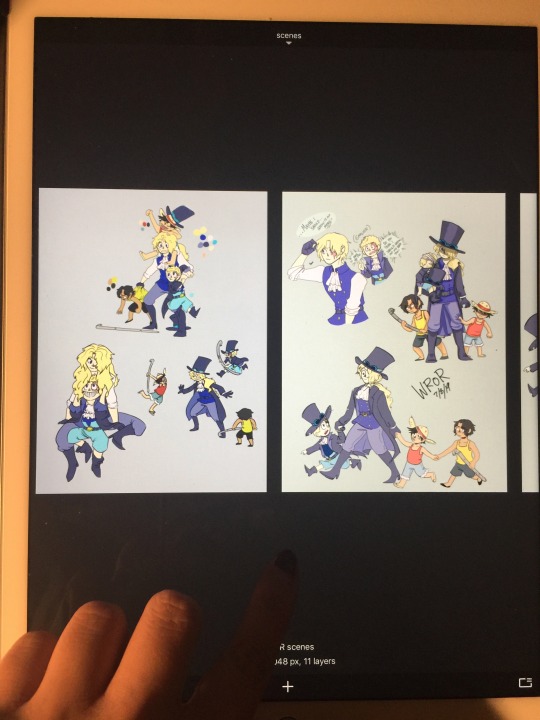
So… yeah thats about everything. this is a VERY long post and yet i only included like maybe ¼ or 1/5 of all the notes i have dbskhjgfkjadns lmk if anyone wants more (or notes for my Other stories, which contain NO WHERE the same absurd amount of shit that wror does.)
#depths' ask#response#idk what to even tag this honestly?? this post is such a mess abhdsjfgdkjn#thanks mido love u dear 💕🎉 im gonna want some damn notes on second chances heads up#wror#wror stockpile#touchmycoat#i started this response at goddamn 3:52am and its now 4:40am#it took me. almost an HOUR#oh my god
5 notes
·
View notes
Text
Your Mom Called, You Left Your Game At Home - Carmilla Fic Review & Recommendation
*New Reviews Posted Every Saturday with one-shots and drabble recommendations Mid-Week*

Title: Your Mom Called, You Left Your Game At Home (Softball AU)
Author: catmilla on Ao3, @chaoticbecky on Tumblr
Word Count: 127K
Chapters: 20
Rating: Mostly Teen but with Mature scenes
Ship: Hollstein
Tags I’d Assign: #softball au #rivals to lovers #enemies to lovers
Author’s Synopsis: softball au in which laura and carmilla are pitchers on "rival" softball teams in the silas parks and recreation softball league. laura takes this very seriously, carmilla does not. laura hates carmilla, carmilla loves riling laura up. laura has a strict (personal) rule against not fraternizing with the enemy (save for her best bro kirsch that carmilla stole for her team on purpose) so, what happens when a dry spell, a losing streak, and a very flirtatious carmilla all finally culminate to laura's breaking point?? read and find out!
Readability: Easy. Reading level and narrative flow make this 127k novel feel more like 80k, so it’s an enjoyably fast read considering the length. In the first part of the story, there are punctuation issues relating to dialog: I.e. Using commas at the end of dialog, within the quotation, but then capitalizing the start of the attribution or descriptive text that goes with it, or else using a period within the dialog quote when it should be a comma because there is still attribution/descriptive text to follow. However, eventually the brain gets used to it and it stops being distracting. There are also some “it’s/its” typos, and a few sentences where the author switches up to present tense when, given the context, it should probably be future tense. But again, overall, it’s very easy to read.
Reviewer’s Plot Summary: The definitive (at least to date) Hollstein Softball AU. Laura Hollis’ life is in a bit of a slump, which is why she’s obsessed with leading her city league softball team to a repeat Championship season of glory. Unfortunately, her team can’t stop sucking. Enter Carmilla Karnstein, captain of their rival team, who lives (and loves) to rile Laura up. Only, there’s history there. Six years earlier, they’d led their highschool softball team to a State Championship season with their mutually stellar pitching skills, and the older Karnstein- who had been a bitch and a bully to Laura as a teammate- had gotten all the glory. Laura still hates her for that, and also for what happened between them at the Championship game’s afterparty. Which is why, as Carmilla now flirts and taunts her into a (fr)enemies-with-benefits situation, Laura is ill-equipped to handle evidence that the object of her hatred doesn’t actually hate her back. In fact, for Carmilla, it’s not her team’s standings that matter: It’s the three-balls-and-two-strikes count where it comes to her heart.
Recommended to Read: Yes. It’s by far my favorite softball AU across any fandom I follow.
Review: There are some conceptual cons to this novel for me, and yet, rereading it never feels like a chore. One half-enemies to lovers, one-half unrequited love, it’s a recreational softball league romance that brings in the feel-good dynamic of the whole gang (Laf, Perry, Danny, Kirsch, Will), a good mix of angst and fluff, and the fun, competitive nature of sports rivalries. The
story is written in third person limited (primarily), with Laura as the narrative focus. Also, if you happen to be a Pitch Perfect fan, there will be a few subtle (very, very subtle) Easter eggs for you.
The Con [Edited]: This time, I’m going to put the negative first and simply address it as a “con” rather than “concrit” because I don’t want to put people off reading it (READ IT!), and also, I can’t fairly call it as much “constructive” criticism as personal preference. But here it is: This is not my favorite version of Laura. For my taste, she is a little too much of “a raging bad person” to Carm.
My issue lies only in my personal moral/relationship tastes, not in something about the story itself, so just take that worth a grain of salt. And, further, there *is* a backstory that explains Laura’s dislike of Carmilla and her difficulty in changing her own opinion. (Although, I would have loved to seen some flashback scenes to their time playing high school softball together. I think it would have been exciting, and also made Laura’s tight grip on her hatred a little more fleshed out.) Finally, I easily concede that upon rereading YMCYLYGAH for this review, I made a conscious effort to try and ‘listen’ to this version of Laura’s words and thoughts in my mind’s ear with a view towards favoring heavy sarcasm rather than the vitriolic hate I took it as during my first read. It helped a lot. And, in fact, it may simply be that I just wasn’t getting it the first time around.
The Good: I *love* softball AUs. (Did I mention I really like softball AUs?) This story has great energy. It does a beautiful job balancing the tension of the softball season with the tension of the relationship plot. The balance between what happens in the main characters’ lives outside of both of those things is also nearly expertly done; there’s exactly enough to make the story and world feel sufficiently fleshed out, but not so much that it drags the plot or pacing down. There are two subplots, one for each Laura and Carmilla, that come into the story at exactly the right relative timings in Act II, both of which weave well into the fabric of the main story to support it without coming off as contrived. The minor characters, likewise, have a perfect ratio of being present and mattering, without becoming distracting. (I appreciate the fact that Danny isn’t an overbearing jerk. #dannydeservedbetter)
Ah hem. Here, also allow me to gush for a minute over catmilla’s Carm. How hard she falls for Laura is so adorable. How thoughtful she can be is cute. The fluffiness of her- which Laura refuses to see- is so sweet that it’s tangibly cotton candy. You root for her. And at times, you *hurt* for her. (Which is probably why I had such a hard time with this Laura, because, “Dammit, Jim, WHY DOESN’T LAURA JUST ADORE CARM BACK??!!”) Yet, this Carm keeps swinging for the fence because she’s so in love. Ungh.
Also,something I always enjoy as a reader, and which I believe is a hallmark of really good storytelling, is when location has a pivotal and evolving role in the plot. Here, it’s the softball field. The author does a great job covering in-game action while not devoting a distracting number of scenes to it. But cleverly, she also made so much *more* happen and orbit around the field that without it, the love story itself wouldn’t exist and wouldn’t be nearly as fun. It is sometimes a wing-man, sometimes a foe. It is sometimes a dance floor, and sometimes a war zone. Day and night, heat or cold, I’ll just hijack the saying, “In life as in [soft]ball, all good things happen at home.”
In conclusion, it’s an easy, satisfying read with laughs, tension, fluff, angst, and sex that isn’t overly smutty.
Oh, and did I mention?
Carm gets the girl.
NEXT IN THE QUE: Vampire Hotel by Jenocide (Ao3) / @heyjenocide (Tumblr)
#carmilla#hollstein#carmilla fan fiction#hollstein fan fiction#fic rec#@chaoticbecky#softball au#rivals to lovers#enemies to lovers#the carm curator#the carmilla curator#@thecarmillacurator#carmilla karnstein#laura hollis#danny lawrence#lafontaine#lola perry#carmilla the webseries
12 notes
·
View notes
Text
okay guys... i’m showing you sneak peaks of a project i may not even go through with, but if I do, i would like some advice on it’s presentation so far
i said i wouldn’t.... but i may do a fucking youtube channel after all
really what will happen is I will post about 10 videos of ideas and theories I already have, and then afterwards I may go quiet, and post when there are other good questions commenters have or if new KHX updates bring up whole new ideas.
I recently bought a mic, but I’m still waiting for it’s delivery so until then I’m making mock ups to help me decide how I want to present things, and its the presentation that I would like advice on- really just thumbnails and the credit card, but i’ll take anything
((on browser, I suggest opening all the images below in a new tab. the pic below is fake, i photoshopped over a random channel just to get the overall vision))

I’m actually planning on using these thumbnails. i tried making them simple and clean [yeah yeah] but is there a way I could improve them? is the text in the thumbnails too obnoxious? I feel like it is, but I also want to make sure they’re readable when they’re tiny on the suggestions sidebar so? Should I make the font size consistent instead of making words like articles smaller? I also tried really hard NOT to be the slightest bit clickbait-y, but is there any title or thumbnail text that makes you think “oh, gimme a break.”? the second video’s title will have “ | KH theory” so people know it’s not confirmed.
and then each video will have a quick flash of the channel’s main title card, and then the individual episode’s title card that looks similar to the thumbnail, but with text closer to the video’s actual title and resizing of the renders.
and then the rest of the video will overall have the same background as the thumbail, with text or screenshots for evidence, like this mockup example:
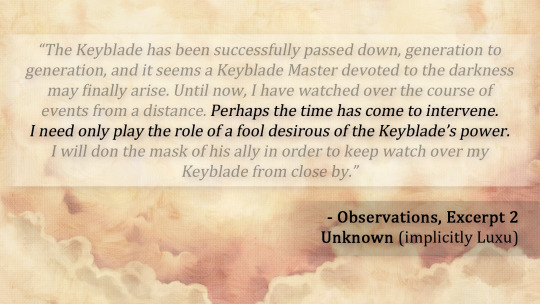
I’m not reallyyyy looking for advice on the screen shot above because I will definitely edit the way text looks so it’s easily readable on each video’s different background, but i’m just including it so you know i’m NOT having clips of cutscenes or gameplay play throughout the entirety of the video. just occasional clips if they’re evidence.
here’s the end card at the end of the videos:

I wont have a long intro or outro video or narration, just the cards for a couple seconds. It’s brown to match the channel’s main title card with Apprentice Xehanort. Am i missing or forgetting anything? I don’t want to link my tumblr because I like how my tumblr community is a little more close nit, but i’m still okay with linking my stock page. but I really dont want large thumbnails of my other videos to show up automatically near the end... that’s optional right? LOL.
I also plan to have every piece of artwork I edit for the videos to be on /khstock as well, as I edited those renders of the foretellers, ava, jiminy’s journal, and demyx in those little thumbnails.
also just to let you all know I do plan on having self-written closed captions available and a transcript in the description, because KH theories get so complex, and being able to read along would make them so much more easier to understand with video LOL
is there anything else that bothers you about a typical youtube channel that i should avoid?
#i just figure if im complaining so much i may as well do something about it asldkfjasdf#also i'm reblogging in the morning when i wake up too#im just posting it rn before i go to bed anyway
54 notes
·
View notes
Note
i mean this as nicely as possible because i love all your thoughts, but i find your posts really hard to follow because of the amount of run on sentences and massive paragraphs! is there any chance at all of you formatting your posts in a more easily readable manner? because i love what you have to say about everything but the way your original posts are formatted at the moment just isn’t accessible at all, sorry
oops this ask is ancient!!
unfortunately to a degree i can’t Really make my long text posts as accessible / readable as they Could be…..sometimes i really Do go too deliberately run-on sentence all in one text block but by this point i think i usually remember not to, but when i’m doing one of those essays i do, i really like, am not trying to like write things in long paragraphs for ~effect~ or The Brand or anything, it’s really really how i manage to write at all versus never making any text posts in the first place, and when i say i Can’t be concise i’m only kind of joking because i truly can’t really write any other way. i don’t pretend i’m always great at going back and heavily editing things (i’m like, very bad at it lol upside down smiley) but i usually find even when i’m trying to go back and add in some paragraph breaks or something, there’s still just a lot of text because the way i communicate (usually both in writing and verbally) is very like….run on and Extended Verbose Thoughts and tangents and all that mess
i’m not trying to say it IS very easily readable or that like “too bad!!” is my answer, just that i do find myself limited on my end too to like, figure out how to modify things to make it easier to navigate
i saw a post that said using like, italics and bolding and stuff helps leave Visual Landmarks that makes text blocks a bit more readable? and those aren’t really features i communicate with hardly ever but one thing i picked up from that is that now when i use the Ellipses to break up a thought (like i do a lot) i try to really extend them like…………………..in the hopes that that also helps serve as a bit of a visual landmark in a Lengthy Bit Of Text………i hope that has helped things a bit??
one tool i know of to help with text blocks in general is the beeline reader extension? it’s for chrome / android / ios and makes every line of text an alternating color gradient to help distinguish them / guide the eye; there’s a few different color / saturation options and i used to use it and it’s helpful and i got used to it / didn’t even notice it pretty soon. it’s neat
i know that alone is hardly The Panacea for readability issues…….i tried to look up like, if there’s any websites that let you copy / paste text that can help break it up more like, line by line? but the only websites i found were all like “how to format your business / academic publication article! don’t use Justified Alignment” like thanks for nothing
i have the Lengthy Ellipses approach but idk if anyone else whose Writing Communication is also kind of clunky has figured out other ways to help with this b/c i’d love to hear if they know of other tips tricks or resources to help with things or provide Options cuz yeah god knows if anyone Wants to read whatever i’m going off about i’d like to facilitate that if i can. there’s just a bit of a roadblock on my end too ugh. i guess i could figure out how to do alternate versions of text posts where i try to really break it up line by line if i’m Really doing an essay?? but idk if that’s the kind of format that would be helpful either, i know it varies smh. idk google was absolutely useless Ugh
2 notes
·
View notes
Text
Transcript Lingthusiasm Episode 25: Every word is a real word
This is a transcript for Lingthusiasm Episode 25: Every word is a real word. It’s been lightly edited for readability. Listen to the episode here or wherever you get your podcasts. Links to studies mentioned and further reading can be found on the Episode 25 show notes page.
[Music]
Lauren: Welcome to Lingthusiasm, a podcast that's enthusiastic about linguistics. I'm Lauren Gawne.
Gretchen: And I'm Gretchen McCulloch, and today we're getting enthusiastic about how every word is a real word. But first, it's almost our second anniversary! Whoa!
Lauren: Yay! Next month is our anniversary month. We like celebrating in November. It will be episode number 26. We can do maths, don't worry. It's not episode 24 because we launched with several episodes at once, but we are very excited about our anniversary month.
Gretchen: Yes! And on our first anniversary, we celebrated by asking you to help more people find the show, and you definitely came through. We ended up thanking almost 100 people in our anniversary post for all your recommendations on social media. And we saw a big bump in listeners, which kept going afterwards and even until now. And so, this year we want to see if we can thank 200 of you for recommending Lingthusiasm to people in your lives.
Lauren: That means we need your help. So if you know anyone who could use a little bit more language nerdery in their lives, this is the month to share the show on social media. Email people, text them, send it to your group chat, or just leave a well-placed sticky note for the person in the office. Writing a review or even just leaving a rating on whatever podcast app you use really helps us so much. It helps other people find the show, and it helps encourage other people to click Play if they happen to come across us.
Gretchen: And it helps your friends who need more interesting things to listen to, who want more fun linguistics in their lives. It helps them find something that they're going to enjoy. If you send us your reviews or tag us in your post on social media, we would love to see them, and we'll be thanking everybody that we know about in our anniversary blog post on lingthusiasm.com. We'll pick a couple reviews to feature there.
Lauren: If you would prefer to recommend us privately, please send us an email with the story of how you recommended us so that we can add you to the thank you post.
Gretchen: Or feel free to just recommend us and not tell us about it. You can still get the warm, fuzzy feeling. Plus you'll get to feel a warm, fuzzy glow of satisfaction both when you recommend us and when we thank you all together at the end. Even if you don't tell us about it, you can still feel that warm fuzzy feeling.
Lauren: Lingthusiasm is an independent show, but we are lucky to have a massive marketing department, which is all of you.
Gretchen: Aww!
Lauren: And we really appreciate when you take the opportunity to share Lingthusiasm with other people.
Gretchen: If everybody introduced the show to just one new listener, our audience would double.
Lauren: So this month, take the chance to recommend us or review us.
Gretchen: We really appreciate it, and so do the people who are about to discover the show because of you.
We also have another way to discover the show, which is two live shows! In addition to the Melbourne live show, which is going to be on the 16th of November, we also added a show in Sydney on the 12th of November, so you can go to either of those shows. Just go to Lingthusiasm.com, look for the link that says Live Show to get tickets.
Lauren: We're really excited to be joined by Tiger Webb in Sydney, who is the ABC’s language researcher. Super excited to also be joined by Alice Gaby for our Melbourne show, who's a researcher at Monash. And we're also thrilled that we will have both shows fully Auslan-interpreted as well.
Gretchen: Yeah, so the topic of those shows is how the internet is making English better. We’re going to be talking about a few bits that are coming out from my book and from other things on the internet, and through texting, and emoji, and everything. There's no knowledge of linguistics or of previous Lingthusiasm episodes assumed, so feel free to bring your friends even if they have never listened to an episode, because then they'll have this whole back catalogue to discover. We're really looking forward to seeing you there and meeting people in real life after the show!
Lauren: Other quick exciting news, we have new merchandise, including adorable space babies, t-shirts that say, “I want to be the English schwa. It's never stressed.” We also have baby clothes that say, “Not judging your grammar, just acquiring it,” as well as new IPA scarf colours and now, IPA ties.
Gretchen: So you can get the International Phonetic Alphabet on various items as well as the clever baby riff on “not judging a grammar, just analysing it.” The baby is just acquiring it; I love this one so much. The space babies are so cute. Everything's coming up babies in the merch these days –
Lauren: Yeah.
Gretchen: – including this month's bonus topic, which is about multilingual babies and raising kids speaking multiple languages. For this and 19 other bonus episodes – there are so many bonus episodes now! It's like twice as much Lingthusiasm. You can go to patreon.com/lingthusiasm and support the show and listen to all the bonus episodes.
Lauren: And while everything's coming up babies, probably about time I let everyone know I'm going to be having a baby in January.
Gretchen: What? What a coincidence! It actually really is a coincidence.
Lauren: That’s actually quite the coincidence that – it’s just baby month here at Lingthusiasm. We are definitely going to keep running all the way through December, January, February, and beyond, so no worries about that. We'll still have our main episode every month as well as your Patreon bonus episode.
Gretchen: Yeah, so we'll be recording episodes, and events, and interviews, and so on in advance to make sure that we give Lauren some mat leave from the show and make sure that everyone here still gets to listen to it. And I'm very excited to hear the results of your new, long-term longitudinal language acquisition project!
[Music]
Gretchen: Have you ever heard, Lauren, someone say, "That's not a real word"?
Lauren: Oh my gosh, like, so often.
Gretchen: All the time.
Lauren: It's just a go-to phrase that people throw around a lot. But when we started talking about this idea of what is a real word and what is not, it seems like such a simple throwaway line. But there's so many things that are happening when people say this.
Gretchen: Yeah, there's a whole bunch of different things that someone can mean when they say, "Oh, well, such-and-such, that's not a real word," and it seems like breaking those down individually can help us understand what's really going on here and why – Spoiler Alert – all words are real words. We're going to come back to that. We’ll keep coming back to that.
Lauren: We'll keep coming back to this very important point.
Gretchen: I don't like to do the fake Myth Bust-y thing where it's like, "It's an open question: Are there some words that aren't real?" Like, no.
Lauren: Absolutely not, spoiler alert.
Gretchen: I'm going to start with the answer and then we get to break it down and not leave you hanging.
Lauren: Yeah, so there's not going to be any "Surprise, everything is a real word" at the end of this. We're very happy to state that as a starting point.
Gretchen: "Are some words unreal?" I think it's one of those questions that's like – that’s like saying, "Are some animals not animals?" Well, you're already calling them animals, like, what are you doing with yourself?
Lauren: Yeah.
Gretchen: Are some words not words? No!
Lauren: The thing I find really interesting about the different subcategories of "It's not a word" is it shows how we conceptualise words and how our brain processes different things in different ways. And how language is both this thing that happens in our brains but also in our particular social contexts and interactions. That's why in this episode, we're going to look at all the different things that people really mean when they say, "That's not a real word". Shall we take a tour, Gretchen?
Gretchen: Okay, let's take a tour.
Lauren: We've given them very serious scientific category names because everything sounds so much better when you give them a very official name.
Gretchen: Yeah, the first kind of thing people mean sometimes is the "blobfish."
Lauren: The Blobfish Reaction.
Gretchen: The Blobfish Reaction. So if I'm like, "Oh, yes, here's a blobfish..."
Lauren: What the heck is a blob – "blobfish" isn't a real word, Gretchen. You just made that up. You're not even sounding science-y by saying this is a blobfish. You're just looking at something that looks hideous and calling it a blobfish. That's not a real word.
Gretchen: It’s a cartoon thing. Blobfish are apparently real animals. I googled "strange animals" to try to come up with the best example of a strange animal, and the blobfish one – hands down, it is really weird and blob-y looking. You should definitely look it up. But more to the point, apparently blobfish exist. Apparently the scientific community probably also has a Latin name for them but definitely also calls them blobfish. This is something that, if you hadn't heard of it, like me half an hour ago, or like Lauren until two minutes ago, you're like, "That sounds fake."
Lauren: I just looked it up on Wikipedia, and they are apparently a fish from Australia. So now I'm feeling very – like I've failed as an Australian.
Gretchen: Oh no. But they don't have a name like "blubbo" or something?
Lauren: No, we haven't called them "blobbies" yet.
Gretchen: Ah, I think that's just a failure of imagination. But yeah, so sometimes your reaction is that's not a real word because: I don't think that's a real thing; I don't even know if that's a thing; or I haven't heard this word before.
Lauren: I felt really embarrassed because I was probably about 26 or 27 the first time I heard the word "isthmus."
Gretchen: Oh, okay.
Lauren: And I just did not have it – it turns out, we just don't have isthmuses in Australia. It's like a peninsula- type thing.
Gretchen: Yeah, it's kind of – I don't know what the difference is between isthmus and a peninsula now that I'm thinking about it. I'm sure someone does but off the top of my head –
Lauren: The difference is that I had heard of the word "peninsula" before I was 27.
Gretchen: I mean, I grew up on a peninsula, but I don't know – and there are, definitely, also some places called isthmuses – isthmae? Isthmapodes? What is the plural of an isthmus? I can't even say this word anymore. It's too difficult.
Lauren: Yeah, trying to have the first reaction of it – instead of being "That's not a word," trying to have the first reaction of, "That is not a word I have encountered yet."
Gretchen: Yes, I haven't heard of that. And how sad the world would be if I knew all the words already. Can you imagine not learning any new words? You'd never have that like, "Whoa, what is that" or "I learned a new thing now." Imagine a world where you've learned all the words. That's a terrible world!
Lauren: Imagine a world where the vocabulary was so finite that you'd run out of new words and experiences to have.
Gretchen: Oh, what a horrible word – world. You know, I'm trying to think of examples of this, because I have definitely heard of words far too late and been like, "Whoa, that's a real thing? Okay!"
Lauren: But also think of how quickly your brain managed to absorb them and accept them. I now very happily accept that "isthmus" is a real word and the isthmus of Oaxaca is a real place because my brain is capable of accepting new words.
Gretchen: And that blobfish are real animals apparently. I saw a graph once that said the average adult between the age of like, I don't know, 18 and 55 or something, learns one new word on average every day. We're still learning new words all the way through adulthood even though we think of learning new words as something you do when you're a kid, or when you're in school, or when you're acquiring a specific technical area, and yet we're picking up new words all the time.
Lauren: We're perfectly capable of it. So the important lesson here is that we don't know all the words.
Gretchen: Erin McKean has a really nice quote about this from her TED talk about redefining the dictionary. She says when people think about a place and they don't find that place on a map, they think there's a problem with the map. But when they find a word that's not in the dictionary, they think this must be a bad word. But it's more likely to be a bad dictionary. And I think that really sums it up. Okay, maybe a word is or isn't in a dictionary, but you've still found it in the dictionary, that is something that's just made by people, and they still have to acquire all the words themselves.
Lauren: That's funny how we go, "I don't believe you that ‘blobfish’ is a real word," but it's not like I'm going to sit here and go, "I don't believe you that Carlton is a real place."
Gretchen: Yeah, exactly!
Lauren: And I'm going to take you to Carlton when you're here because there's great ice cream.
Gretchen: Okay, good. Yeah, like, "Oh, Lauren, I haven't been to Carlton. I didn't know there was –" actually, there's a Carlton in Canada as well, because the Brits and colonies and stuff. It's the name of a University in Ottawa. So I've been to that Carlton. I'm like, "That's a real place." But my Carlton is not the same as your Carlton.
Lauren: Well, that is probably true in this case.
Gretchen: I think there's kind of a subset of this category which is using an existing word in a different sort of way. One of the things that I did for my very scientific research of this episode was I looked for the quote "isn't a real word" and "not a real word" to see what kinds of words people were saying were to be a word. So this is how we came up with these different categories as we took what people were saying about something not being real words and we kind of broke them down into the different types of things people do. And a couple that we came across people saying weren't real words were things like "learnings," which is, I guess, used in teacher jargon to mean: the learnings; the learning outcomes; or the learnings that the students will derive from this lesson are blah blah blah. I haven't heard "learnings" being used in that particular context, but I definitely believe that people could do it. And the annoyance that I was seeing with someone calling that "not a real word" was more about being annoyed with jargon, or being annoyed at using an existing word in a different sort of way that the other person wanted to be like, "No, that's not legitimate. I don't want to acknowledge that one."
Lauren: And again, it's this "I have never come across this before so it must be wrong" not "I just haven't had my brain expanded for this new category."
Gretchen: Maybe there are more things in heaven and earth, Horatio, than have been dreamt of in your philosophy, or your learnings as it will.
Lauren: It's also very likely – you could almost reliably put money on this, but especially the ones that people keep coming back to, like "impact" as a noun is one that people complain about a lot. And, like, there’s over years of records of people using that word in that way. Generally, these ones become recurrent cycles of outrage when there's no good evidence that other people haven't been happily using it this way for a very long time.
Gretchen: Yeah, either it's been used that way for a long time or it hasn't been, but we could start doing it now. It's fine. People seem to pass along their annoyance with corporations, or with their boss, or with stuff of being kind of new to you and therefore opaque or difficult to understand, with the annoyance of the words themselves, when they're just – you know, the words are innocent here. They're just channelling your feelings towards the boss or the – you know, there's a lot of corporate jargon going on, or something like that. Saying "learnings" – if people are using it as a word; It's a word now. And "impact" has been a useful verb and noun for many hundreds of years.
Lauren: The next type of "that's not a word" reaction you find is an extension of that form that we just talked about, which is what we're calling the Funner Reaction.
Gretchen: When I came across this one, I specifically saw a lot of people using words like "funner" and "funnest" and self-consciously saying of themselves like, "This game is funner than the other one. I know that's not a word." So rather than using it as a criticism of someone else, like I noticed with the other kind of examples, people were using it as kind of a pre-emptive self-criticism, like, "Yeah, I know this isn't a word. Don't make fun of me for this, but it's something that I want to use right now." And I think that's slightly different.
Lauren: It's something you want to use, and it makes complete sense. So it's something like "impact" as a noun is completely codified in English. There's lots of examples. Things like "funner" or "necessariness" or "squishable" are all words that might not be in a dictionary, but we know what each of the individual parts of that are. We have English morphology that's sufficiently consistent and transparent that we understand what all of those bits are doing when we combine them, even if they're not codified normally to go that way.
Gretchen: Yeah, you can add "-able" to a whole bunch of words. You can say "squishable," or "huggable..."
Lauren: "Doughnutable."
Gretchen: "Laughable," "doughnutable." I think a lot more things should be "doughnutable" or "ice-cream-able."
Lauren: Yeah.
Gretchen: Are the same types of things doughnutable that are ice-cream-able? Like, this is great! It's really cool that language can do this, and it's a shame to see people limiting themselves from this. Well, kind of not limiting themselves, but then adding this pre-emptive fig leaf because we're so used to limiting ourselves by not doing this type of linguistic play. It's there to be played with. Let's play with it.
Lauren: Especially if you are – it's interesting that people feel they have to police themselves on social media, which is a more playful and informal – maybe don't start using non-standard combinations of bits of words in, like, a job application or your Nobel Prize speech. Maybe stick with some more standard forms there. But if you can't play around with language on social media, it's a bit sad.
Gretchen: Yeah, well, and I think the question is not so much where is making up words or where is playing around with words appropriate, but where is play appropriate. You know, certain types of environments like a formal dinner or something aren't necessarily appropriate for playing with your food or playing with your words, but that doesn't mean that other environments aren’t appropriate for this. You know, there is a space for play.
Lauren: Look! I’ve made my soup doughnutable!
Gretchen: Maybe don't do this if you're having dinner with the Queen. Maybe don't. But that's a feature of a particular social situation, a broader social context, and I think we have the sense that language should be more rigid than even other areas where – you know, an experimental chef is admirable. Or if you're good at experimenting in the kitchen, that's a good thing you can do. And yet, people feel the need to apologise for experimenting with their vocabulary. Don't apologise! This is great. This is a feature, it's not a bug.
Lauren: I feel like there are some really expensive restaurants where you pay a lot of money to have ice-cream-ised to soup.
Gretchen: Oh no. It's worth experimenting with this. Some of them are almost so well used that they've taken on status of their own. A lot of people will observe, you know, you can be "overwhelmed," you can be "underwhelmed," but can you be just "whelmed"? Or why can't you be just "whelmed"? Some of these have been around for a while.
Lauren: Poor whelmed. It got abandoned by its cool, more morphologically complex children.
Gretchen: Yeah, its children abandoned it. But yeah, let's play with these things.
Lauren: So "whelmed" was a word. It was a completely normal word, and we added "under-" and "over-" and then we forgot about "whelmed." And now people say "whelmed" isn't a real word. Poor whelmed.
Gretchen: It was real for a while. Why can't it come back? But I think it's a matter of perception. If people start using "whelmed" again, people will figure out what it means.
Lauren: Like a horse getting into a unicorn costume and it no longer exists.
Gretchen: I think another reaction that I see from "Okay, is this a word?" or "Can this be a word?" is what I'd like to call the Schadenfreude Reaction, which is like, "Well, the Germans have a word for this."
Gretchen: We English speakers, we can't possibly, but the Germans must have a word for it. This one always – it’s a very particular kind of reaction because it's a sense of, "It'd be great if we could create a word. It would be nice if this type of thing existed, but I can't possibly do that as an English speaker. We need to go to another language and let them do it," which is a lot of what the history of English-speaking science and philosophy have done, is just go to Greek or Latin and make them create a word, and then borrow it into English, because somehow that seems more legitimate. These days, it's German. But it's the same sort of thing. And I think it's that we create words in English all the time and yet we have this sense of like, "Oh, maybe someone shouldn't do that," or those kinds of things. In particular, German is very good at creating words by compounding them.
Lauren: English is also good at creating words by compounding them.
Gretchen: Yeah!
Lauren: It’s just that we still leave a space there.
Gretchen: Yeah, I found someone saying that for some reason they thought "apple lovers" wasn't a real word. And I was very confused about this because surely all English speakers recognise "apple" and surely all English speakers recognise "lovers." So I guess they're asserting that "apple lovers" together isn't a real word. But you just made it. Congratulations! Now it's real.
Lauren: But it's got a space there, Gretchen, and I'm very anxious about the fact that a word is a thing that has a space on either side of it.
Gretchen: Well, maybe this is the point of the podcast where we have to say: For all that we're saying all words are real, there's another linguistic sense in which a word isn't even a linguistically meaningful unit because where you put your spaces is a certain kind of arbitrary.
Lauren: It's as much a product of the history of our writing system as it is anything else.
Gretchen: Yeah, and the same thing that gives German a word like "schadenfreude," which is literally just "schaden," which means harm or damage, and "freude," which means like happiness or joy, and they're like, "Oh, harm-joy." English could do this too. English does the same sort of thing by smushing together multiple words. There's just – we're more likely to leave a space there and less likely to shove them together. If you wanted to say "apple lover" in German, you could definitely do that. It’d probably be something like "Apfellieber." But you just wouldn't put a space there.
Lauren: Oh, that's right! We should use that in English.
Gretchen: But we could just say "apple lover"!
Lauren: So we could accept that having a space in the middle of something doesn't prevent it from being a word.
Gretchen: Yeah, and there's lots of – you know, dictionaries are really good at adding compound words even if they have a space in between them. It's just they seem like two words for the purposes of – if you're doing word count on your Word document, to be like, "How many words is in here," it will count them separately because they have spaces. But a lot of things like "greenhouse," or "chalkboard..."
Lauren: Smartphone...
Gretchen: Smartphone... You know, those started out with a space in between them and then we gradually got rid of the space. German just goes a little bit faster than us in getting rid of the space.
Lauren: There's also one that I'm sure you have an example from when you were, perhaps, growing up or when you move to a different dialect area, where someone essentially tries to shame you for using a form that isn't part of standard English or is less-used in standard English. We've called this the Ain't Reaction.
Gretchen: I think "ain’t" is the quintessential example of this, because it's so present in so many varieties of English, and it's so shamed in all of them where it’s present, and yet it's still there, and it's still alive and kicking in English. People write letters to the editor about finding it in dictionaries like, "Aaaargh, this shouldn't be there and it's because it's not real," and there's so much animus towards "ain't."
Lauren: How many decades and centuries of people telling other people "This isn't a real word" has it been and "ain't" is still going strong? It just makes me so happy.
Gretchen: Yeah, good job "ain’t," you're a fighter. Well, it starts out as a contraction of "amn’t," like "am not." "Is" goes to "isn't," but what does "am" go to?
Lauren: Amn't!
Gretchen: "It isn't," but "I amn’t." That eventually turns into "ain't." That's why there's no "amn’t" now. Except I think there is in a couple dialects, but not in most dialects. So "ain’t" takes on that function, but then once it stops sounding directly like "amn’t," it's like, "Well, I could just expand and work for all of the different pronouns!" It's very versatile. It's super useful. And yet it's highly, highly stigmatised. The way that that stigmatisation is expressed is, specifically, in this "not a real word."
Lauren: I think it speaks to the fact that "not a real word" gets used as this really broad, un-reflexive, unconsidered response to this thing that clearly is a word people use all the time and that the only reaction you have is "That's not a real word" instead of "That is a word that is considered informal and is probably best not used on this tombstone."
Gretchen: I’m sure someone’s used it on a tombstone. Yeah, I think there's a lot of nuance in that. And this is one of the examples where "That's not a real word" gets used to shut down discussion and shut down argumentation, especially like, "Oh, that's not a real word." "Well, I looked it up. It's in the dictionary." And then you're like, "Well, that's a bad dictionary now because it had this not-real-word in it." It's one of those things, like, you can't have an argument with somebody who won't at least acknowledge what would have to exist in order for them to be proven wrong.
Lauren: Yeah.
Gretchen: You know, if you say, "Well, would you accept that dictionary as a source"? And then you show them the word in Merriam-Webster or Oxford – all the dictionaries have "ain't" – and then you show them there, and they're like, "Well, I don't accept this as a source either." You're like, "Well, you just changed the goalposts now." Who do you accept as the ultimate arbiter for what is or isn't a word? Or is anyone who makes the assertion something isn't a word automatically the correct one?
Lauren: I just feel like if someone says to you, "That's not a word," it's really unfair that the burden of proof falls on you.
Gretchen: But I'm like, "Here's a store that's there." And you're like, "Nope. Not a real store because it's not in the yellow pages yet." I'm like, "But you can walk into it. It's a store that will sell you things." They're like, "Nope." No one's ever asked, "Oh, not a real word? Well, define a real word. What is a real word?"
Lauren: I guess the challenge here is – the easy response is to say, "Well, here's evidence that it is." But often when people are saying this, there is something here that's about language policing, and it's often cover for some kind of classism, or racism, or it's particularly picking on the language of a particular subgroup, or it’s covert sexism. So there is something here that's unpleasant, and I wish people would stop doing.
Gretchen: But even when I agree with them, it's also still an argument made in bad faith.
Lauren: Yeah.
Gretchen: You know, it's not – if someone says, "Well, you know, this isn't a word," even if I agree that this was probably a typo that someone made, or this is something that maybe wasn't appropriate to a particular context, legitimising the argument that "not a real word" is a reasonable response to anything is still a problem, even if the core thing that they're getting at might have some utility in the context because it's so undefined, and it's such an easy way of covering for classism and racism and all sorts of these kinds of discriminations that people smuggle into language.
Lauren: Yeah.
Gretchen: The problem is the incorrect ideas about how language works, not the particular words being used. Another type of word that people have the reaction "It's not a word" to is a word like "smush" or "smoosh" or "aaaargh."
Lauren: So things that are more representative of sounds, or reactions, or feelings that are often informal, or onomatopoeia.
Gretchen: Yeah, and I think this begins to get into like, "Oh, it's not a word because my computer gave me a red underline when I tried to type it." There are lots of different ways to try to spell "aaaargh," and I definitely don't think computers, generally, have all of them. That doesn't mean that a particular one isn't going to be the exact one you want right now but, thinking about those areas, we're trying to represent certain moods, or certain feelings, or certain onomatopoeias, or certain other kinds of sounds that exist in nature or in the depths of our soul, like "aaaah." These are hard to write adequately.
Lauren: And a lot of onomatopoeia in English is a bit not-standardised, and people kind of play with it a lot. In other languages, it can be more codified into the language. If you think about onomatopoeia in terms of the sounds that animals make, we have lots of codified ways of doing that. You know, pigs "oink" and ducks "quack," and that's very codified. You'll find "quack" in the dictionary. And you'll probably find "oink" in the dictionary. But, essentially, language is very messy at the boundaries in the way that what is a word and isn't a word – and you can't just be like, "Well, it's got a space." That gets a bit fuzzy at the boundaries. The same with this. So like "smush" might be more of a word than "aaaah," which is perhaps all that easy to say. And, you know, "haha" is more of a word than [laughing noise] in terms of laughter.
Gretchen: Yeah, but there's a certain kind of intentionality to them too, which I think distinguishes even something like "aaaargh," which can be spelled in a whole bunch of different ways, from something just kind of randomly mashing on your keyboard, or having your cat walk across your keyboard –
Lauren: Or actually screaming, which we won't do for the sake of your ears.
Gretchen: Yeah, no screaming on this podcast. If you'd like to scream, please provide your own scream here. But there's a certain conventionalised way of representing those, and they have a certain recognisability to them and language-specific way of doing them, even if there's also this flexibility around them as well.
Lauren: At the opposite end, moving back to things that do fit within our expectation that they only have spaces on either side, they usually have relatively regularised spelling conventions, but people get very upset about them, is when brands make forays into word creation.
Gretchen: Oh dear.
Lauren: And because – I think one thing that upsets people about this a lot is – when it doesn't feel forced, we don't think about it. And we accept a squillion brand names into our lives, and they just get absorbed, and we’re completely fine with it. And then there are times where it just feels very forced, and so...
Gretchen: It crashes.
Lauren: I have named this the Tronc Reaction when people say "That's not a word." So "Tronc" was the Tribune Publishing Company. Quite a few years ago they rebranded themselves to Tronc: T-R-O-N-C.
Gretchen: Yeah, which was just – they got kind of widely made fun of for it on social media as just like, "Why have you picked this name? It's so ugly. It's plunky. It's tronc-y. It's not a good name."
Lauren: And there is something about – you know, it doesn't have a particularly standardised English spelling – it's T-R-O-N-C – but it definitely fits. It's not like it's against the kind of sounds that you can put together in English.
Gretchen: Yeah, and it definitely sounds a bit, I don't know, like, plunky. It's a bit clumsy-sounding. But we've incorporated so many weird words into English, things like Xerox or Kleenex, which have a lot more X’s than a normal English word does, or something like Google or Twitter, which sounded very frivolous when they were first introduced, and now we're just like, "Oh, yeah, of course, I'm going to google it." And it doesn't seem weird to us because we're so used to them.
Lauren: And I think it's partly that we're very happy to accommodate new words when we need them. So Google sounded pretty silly when it started, and now we talk about googling things to the point where, if I'm trying to find something in a document, I'll sometimes be like, "Oh, I just have to google for that word." It's like, I'm not even in the proprietary search engine. It's just become the handy word. So if the language needs that word – whereas I don't talk about "Bing-ing" anything.
Gretchen: But, yeah, like, "I’m going to go Yahoo it."
Lauren: I don't have any particularly strong feelings about either of these search engines.
Gretchen: But one of them is definitely a lot more verb-y.
Lauren: One of them has definitely verbed into English a lot more happily.
Gretchen: I even use "Skype" to indicate for general video calls even if I'm not actually using Skype’s platform.
Lauren: Oh yeah, it doesn't matter what platform I'm using, it’s still – that's become generic.
Gretchen: It's like, "Hey, Lauren, do you want to Skype?" And then of course it's gonna be on Google Hangouts or something. It's not gonna be on Skype.
Lauren: Which is problematic for companies. You know, when their brand gets used generically, it means that they lose some of the brand copyright power. But I think it shows that language can be quite accommodating. I mean, English does love adding new words all the time. Whether they come from a top-down company or not seems to be a bit arbitrary. But it's the thing about when we need them.
Gretchen: Yeah.
Lauren: You know, Skype came around as the first video platform that I use.
Gretchen: It's when we need them or when – it's something that people decide for themselves kind of bottom-up and not, I think, something forced down. Another one that I had a lot of fun with seeing people do on this was – so somebody replied to the Pope's Twitter account, where the Pope was talking about the Beatitudes, which is – it's a thing in the Bible, I don’t know. Being like, "'Beatitudes' isn't a real word." It's like, "Look, guys. This is the Pope."
Lauren: I probably can't tell you what a beatitude is off the top of my head but, frankly, if the Pope is talking about them, he probably thinks they're real a word.
Gretchen: Yeah, yeah. Like, "Is this really the hill you want to die on right now?" Like tweeting at the Pope being like, "This obscure bit of theological terminology, which you have spent your entire life studying, is not a real word." I also found somebody saying that "gubernatorial" is not a real word? And I agree this word looks weird.
Lauren: I kind of almost feel compelled to agree. There is some story here where "governor" and "gubernatorial" came into English through slightly different – There's always the French-from-Latin paths.
Gretchen: Okay.
Lauren: And like, one of them came in via Latin via French, and one of them snuck in straight via French or something. And that's why "gubernatorial" is – it should just be "governatorial" if we're going to have a regularised system. But English, like any language, can handle quite a bit of irregularity in the vocabulary.
Gretchen: Yeah, and you get the impression people who are using arguments like this – you know, they're not really saying to the Pope like, "I don't trust your command of the English language," especially the Pope’s social media officer, who probably isn't even the actual Pope. What they're saying is, "This is an argument that I can make that" – like, we're talking about the beginning. You can use this as an argument even if you don't believe it, because it immediately shifts the burden of proof to the other person to say, "No, this is a word and here's why," and not to you for being like, "Well, why don't you think so?"
Lauren: It kind of reminds me of a subset of this, which I like to think of as the Mansplain Reaction, which is where you say something's not a real word because it conflicts with your worldview, essentially.
Gretchen: I really like an example of this that I found, which was somebody saying that "conspiracy theory" is not a real word.
Lauren: Oh, okay.
Gretchen: I know!
Lauren: Why is "conspiracy theory" not a real word? Is it because it has a space in it? Gretchen, we've been through this one.
Gretchen: No, somebody said it's a made-up mind-control word that causes one to dismiss the facts of any investigation. I was like, "Oh, okay."
Lauren: This is a pretty prototypical example of a Mansplain Reaction.
Gretchen: Yeah, so it's like, "I don't like the concept expressed by this word, so I'm going to attack the word not the concept," or say like, "It was unnecessary to name this concept because I don't think the concept is important or I don't think the concept exists."
Lauren: There's no such thing as "mansplaining." We’re just having a conversation in which I am aggressively disagreeing at you.
Gretchen: Right. I think the big problem that I have with the "not a real word" argument is it implies that there are some sorts of words that aren't real. But by the time something exists for you to say, "It's a kind of word," that's all it takes to be a real word.
Lauren: And words are words by consensus. No word is a real word. Every word has to start off by a group of people agreeing that this string of sounds has this particular meaning. And some people in some contexts have more authority in naming these things. You know, I will probably trust a doctor in telling me whether a word means a particular thing in terms of medical usage. I will definitely trust someone to tell me what their name is rather than trusting myself.
Gretchen: Yeah, I think there are certain kinds of authorities. A person is the ultimate authority on what their own name is, and, by that logic, linguists should be the ultimate authorities on whether words are real or not. And what we're telling you is all the words are real.
[Music]
Gretchen: For more Lingthusiasm and links to all the things mentioned in this episode, go to lingthusiasm.com. You can listen to us on Apple Podcasts, iTunes, Google Podcasts or Google Play Music, SoundCloud, or wherever else you get your podcasts. And you can follow @Lingthusiasm on Twitter, Facebook, Instagram, and Tumblr. You can get IPA scarves, IPA ties, and other Lingthusiasm merch at lingthusiasm.com/merch. I can be found as @GretchenAMcC on Twitter. My blog is AllThingsLinguistic.com.
Lauren: I tweet and blog as Superlinguo. To listen to bonus episodes, ask us your linguistics questions, and help keep the show ad-free, go to patreon.com/lingthusiasm, or follow the links from our website. Recent bonus topics include: hyperforeignisms, multilingual babies, homonyms, and an inside view of the gesture and emoji conferences. And you can help us pick the next topic by becoming a patron. If you can't afford to pledge, that's okay too. We also really appreciate it if you can rate us on iTunes or recommend Lingthusiasm to anyone who needs a little more linguistics in their life.
Gretchen: Especially this month when we're doing our special anniversary round of recommending to help the show grow! Lingthusiasm is created and produced by Gretchen McCulloch and Lauren Gawne. Our audio producer is Claire Gawne, our editorial producers are Emily Gref and AE Prévost, our production assistants are Celine Yoon and Fabianne Anderberg, and our music is by The Triangles.
Lauren: Stay lingthusiastic!
[Music]

This work is licensed under a Creative Commons Attribution- NonCommercial-ShareAlike 4.0 International License.
55 notes
·
View notes
Note
why do you type each sentence in a new line like that?
splitting a wall of text into paragraphs makes it more readable sure. but if you do it for every other sentence
it makes it harder to read
when your eyes are constantly jumping back and forth in between chunks of information

Oh!
Just a bit of a habit at times, sorry!
Admittedly, my writing is a bit better when I'm actively RPing, cuz then I have Character Text and Character Narration separately
Although I do have to admit, yeah that last post was kinda wonky for me to read again as well
I am editing it as we speak
It's not really new lines for each new sentence usually
It's just kinda how I type?
I can only assume it's breaking up lil topics or breaking text into lil chunks so it's easier to read

Although I'm looking back up at the rest of this and, well
I think when chunks or lines are the same shape or length, that adds to the reading difficulty as well.
Definitely something I'll have to try to figure out soon!
0 notes
Text
Best OCR software of 2018
New Post has been published on http://www.dailygadgets.net/best-ocr-software-of-2018/
Best OCR software of 2018
Digitizing paper documents has a lot of benefits for individuals and businesses alike, clearing up huge swathes of space where filing cabinets once stood, and meaning documents are protected against theft, fire and flood.
For this paperless process to make sense though, you really need to add OCR (Optical Character Recognition) into the mix. OCR software scans digital documents to make the text inside them readable by a computer, so you can search them just as you would anything you’d created in Microsoft Word or Google Docs.
Here are our picks for the best five OCR apps we’ve come across, all combining an intuitive interface with a stack of useful features.
1. Google Drive
A quick and easy solution from Google
Leverage the power of Google
Straightforward and automated
Not the most advanced file manager
Whether you use Google Drive as an individual or as a business (as part of G Suite), you can tap into its OCR capabilities. In fact, everything is switched on automatically: any PDF or indeed any image you upload to Google Drive is scanned for text.
That text can then be easily searched from inside Google Drive or inside the specific document itself. You can try it for yourself right now – just search for a line of text that you know is inside an image in your Google Drive, and up it pops. It all works as if by magic.
Of course Google has plenty of training data and cloud processing power to work on this, so you would expect the results to be impressive, as indeed they are. Having a few more advanced search functions and features would be welcome, but it’s hard to fault this as an integrated feature.
If you’re using the Google Drive app for Android, you can scan documents straight in from the app, using the camera on your smartphone. Otherwise, get your documents uploaded via a scanner attached to a computer, or any other method you like, to start the OCR processing in Google Drive.
2. Nuance OmniPage Ultimate
Custom, comprehensive workflows
Top-ranking speed and accuracy
Too expensive for some
If you take your OCR scanning seriously – if it’s a crucial cog in the machinery of your business – then give Nuance OmniPage Ultimate a look. It’s packed with features above and beyond what you might expect, and while the price is relatively high, it still falls in the affordable bracket for most small businesses.
Put down your cash and you can convert paper documents from virtually any scanner source into just about any kind of digital file you like – and everything works super-fast too. If you’ve got stacks of paper to get through, the time saved by OmniPage Ultimate can really start to add up.
Known for its accuracy in conversion, this Nuance software is trusted by some of the biggest names in business – including PWC and Rolls-Royce – and lets you build up custom workflows so your documents get automatically delivered to the right place in the right format, depending on your needs.
If the Ultimate edition is a bit too rich for your blood, try the cheaper OmniPage Standard, which doesn’t include as many input, output and workflow options, but is going to offer more than enough in the way of features for most users needing an OCR solution.
3. Abbyy FineReader
One of the veterans of the field
Comprehensive suite of features
Multiple output options
Expensive for personal use
Abbyy has been helping companies manage documents for a long, long time now, and it shows in the latest version of its FineReader software – it’s just about as comprehensive a solution as you would want for a small businesses, though casual users might prefer something a little more lightweight.
You get all the tools you need for taking paper documents from a scanner and making them fully readable, neatly organized, digitized documents. As well as recognizing text and converting it to PDF, Microsoft Office or other formats, the program can also compare documents, add annotations and comments, and more.
If you need to convert bundles of documents in batches then FineReader can do that too. It can handle a host of output formats and 192 different languages without breaking a sweat, and there are companion mobile apps as well if you need to do some quick scanning from a phone.
The software isn’t the most modern we’ve ever seen but it’s clean, functional and does the job perfectly well. Abbyy FineReader has built up a strong reputation for being one of the best options in the OCR field, and you can take advantage of a free trial to see if all the hype is on the money.
4. Adobe Acrobat Pro DC
A trusted solution from the Adobe stable
Plenty of advanced features
Easy to use
You’ll have to pay month after month
Want to go with a well-known brand name you can trust? Adobe Acrobat DC fits the bill, and brings along with it an impressive list of features and options, even if the price is a little steeper than some of its rivals. For all the OCR features, you need to opt for the Pro version of the Adobe Acrobat software.
That DC stands for ‘Document Cloud’ by the way, and everything integrates rather neatly with Adobe’s cloud solution, should you need to get at your files from any computer. Of course there’s also slick and seamless integration with everything else Adobe makes, so you might consider this if you already use a lot of Adobe apps like Photoshop.
If you do decide to pay up for the Pro version of Adobe Acrobat DC, you get all the OCR basics plus the ability to add comments and feedback on documents, a specialized tool for scanning tables, the option to quickly compare two documents together, and much more. Documents can be edited right on the screen just seconds after scanning them in.
The Adobe badge guarantees a certain level of quality, and we’re impressed by the intuitiveness and the scope of Adobe Acrobat DC. If you don’t mind adding yet another subscription to your life, then this is well worth considering.
5. Readiris
A product that’s packed with features
Comprehensive all-in-one solution
Easy to learn and operate
More advanced features cost extra
Readiris blends a polished interface with a host of useful features and functions to really earn its place on our list. If you’re running a small business or need a serious amount of paper digitized – and you’re prepared to pay for it – then you’ll find this program one of the most comprehensive out there.
From a host of supported file formats (including Microsoft Office formats and the option to have text read aloud), to signatures and security protection on your finished digital documents, it’s difficult to think of anything that the developers of Readiris have missed out. Watermarks, comments and annotations are all supported.
It’s also one of the fastest and slickest OCR programs out there, putting some older applications we’ve seen to shame. Documents are processed and filed rapidly, and you’ll soon be jumping quickly between the various Readiris screens, with no need to consult a manual or embedded help file. Like all the best apps, it combines a lot of powerful features with a simple and accessible interface.
Some features, such as support for a maximum of 138 languages and PDF password protection, require a Corporate level package. The one below that level is Pro, and then the basic product is just the standard Readiris – and it’s still very good, so many of you will be able to get by with the lowest priced package.
1 note
·
View note
Note
Hi I'm stalking your art tag because you're SO GOOD and just?? How did you improve so much? My art looks the same from like. 10 years ago. How do you do what you do
First of all, thank you so much!! You’re such a sweetie!I am by no means an art teacher. I feel like you have to have a certain mindset to be a teacher, and I don’t have one of those mindset. I’m not good at it, so I don’t teach, but I will give you some really helpful stuff I wish I’d figured out earlier.
Second of all I’m going to give you a boring answer you don’t want to hear and I don’t want to say:
Practice.
Now, here’s the more fun answer that I’m hoping is more helpful:
Practice while you’re going. Every time I draw is a chance to practice. I’ll draw and redraw poses and edit them about a dozen times before I settle on it for lining! In one of my most recent drawings I have AT LEAST 29 layers of me drawing, redrawing, and tweaking the poses.
Practice can mean sitting down and doing 20 hand sketches, or practice can mean something different. Find out what method of practice works best for you. Sometimes drawing a thousand hands doesn’t help, and it’s okay if it doesn’t help you. Find another method!
Don’t settle on your first draft! Redrawing something is not only improving the drawing, but giving you experience for the future!
Draw from life, i know, that’s really basic. But still, it helps!
Make practice fun! Motivate yourself to practice by using things you enjoy drawing. Are you garbage at drawing hands, but you love drawing aliens? Draw aliens with a bunch of hands. This is a really basic example, but you get the jist!
My babe and I recently (before I came down with tendonitis and had to take a break) would watch a dance video where the dancers are wearing relatively snug clothing, pause it at a random place, set a timer for 5 minutes and draw whatever pose we got. (you can obviously do a shorter time if you want!) It helped a lot with foreshortening, movement, and making bodies look more 3d.
Speaking of which this won’t help your art any but it’ll help your health: S T R E T C H before, after, and while you draw, okay? You know that tendonitis I mentioned? Yeah, guess who didn’t stretch. Find stretches that work for you. Wrists, back, neck. Walk around a little every once in a while. Drink water. Eat. Take care of yourself.
Practice SMART, not just practice. Figure out what you want to strengthen in your art style. If you want to focus on improving the fluidity or readability of your poses, doing half hour studies of detailed landscapes or portraits isn’t going to help with that. Doing 1 minute speed-sketches of exaggerated poses might, though. Same goes for if you want to get better at drawing landscapes and detailed portraits.
You’ll get something out of it, so if you want to do these things do them! They’re fun! but don’t draw nothing but anime eyes and wonder why you can’t draw a skyscraper perfectly.
REFERENCE. U S E R E F E R E N C E
I’m gonna break this wall of text up with a doodle of a kitten because it’s a lot

Don’t be afraid of shitty anatomy! Sometimes to get the right perspective, it has to look weird. Making mistakes helps you learn what to improve. What works and what doesn’t. And, in my experience, the pieces I obsessed over were the pieces I felt like aged the worse, while pieces I had fun doing and relaxed drawing are still pieces I really love.
All in all, just don’t be afraid of mistakes. You’ll make them, just have fun making them.
EXPERIMENT, EXPERIMENT, EXPERIMENT! Experiment with colors. With more lineweight, with less lineweight, with weird anatomy and proportions, try out aspects of art styles you love, try out aspects of art styles you hate! Just have fun!
Step out of that comfort zone! Learn something new! You don’t have to curate an entire art exhibit on horses if you can’t draw horses, but sketch a couple at least.
Take bits and pieces from everywhere and adapt them to what works best for you. Does this method of sketching not work for you? Okay, change it. Find a new one. Find one that works better. That includes this list of tips! If something I’m saying doesn’t work for you? IGNORE IT! find something new. Don’t try to force yourself to work in a box that doesn’t work for you. It’ll just make you feel inadequate, and instead of spending time improving, you’re spending time trying to fit into the box.
I can’t give you too many super specific tips because I don’t know your art style or what you want to improve, but in general, just experiment and adapt to whatever works best for you.
This one is more of a catch all for developing your art, not nesecarilly improving it: Don’t treat things like color theory as sacred rules of the land that cannot be broken. Learn anatomy, learn color theory, learn about lineweight and how it works, learn about light and shadow! But keep in mind; they’re a guide for how things work, not an instruction manual. Do whatever you think looks cool, even if that isn’t what other people say looks good.
Learn at every opportunity! You think that lighting is cool? Try to replicate it. You watched a speedpaint and you liked their technique? try it out for yourself. Like that color palette? Analyze what you like about it and try to replicate that feeling.
Draw as often as you can! And “draw as often as you can” does not mean draw until your hands and arms hurt! It means draw a little when you have some time, if you have the energy. Don’t hurt yourself.
Time for another kitten break

Take a step back if you don’t like how something’s turning out. close it up, have something to eat, sleep on it, work on something else, whatever. If you’ve just been looking at it too long, that’ll fix it. And if there’s actually something off, you’ll come back to it less frustrated and with fresh eyes!
Draw fingernails on hands. This sounds really weird and dumb and random but it literally upped my hand game by at least 25%. It does WONDERS for portraying the angle of the hand.
A major chunk of my artistic development and improvement was done in a very unhealthy way. When I was younger, I would push myself to pain, I’d stay up until 3-6 am drawing something, I’d cry at least once every two weeks because I wasn’t good enough. I improved a lot very quickly, but I pushed myself way too hard because I was so desperate to improve…
Don’t do that. I mean it. I’m very thankful for the growth i achieved in that time, but if you can avoid that phase, do. It’s better to improve slowly and keep a healthy relationship with your art than to push yourself so hard that art becomes a chore and you lose your passion, or even hurt yourself.
Finished not Perfect
Your art has improved!! I promise it has, it may not seem like it but it has! You don’t see it right away, but every single drawing is a little better than the last as long as you keep striving to learn a little more with every drawing. Everything grows at a different pace, and you’re growing at the right pace for you.
You’re good enough right now! Have goals for what you want to do with your art, not standards for how “good” you need to be!
I’m sorry this post is long, I wish I could say “I sacrificed my soul to the art demons” but… I can’t say that. I didn’t do anything special.
Draw as much as you can, draw what makes you happy, draw new and exciting things, and surround yourself with art, artists, and people that inspire you!
BEND ART TO YOUR WILL AND MAKE IT YOUR PET
If you know an art demon that might help too idk?
aaaand here’s one more incredibly small, incredibly round kitten

#long post#litriu text#art advice#probably incredibly questionable art advice#my tips and tricks for art pretty much amount to#'idunno sound' + have fun do whatever you want#palepinkroses
53 notes
·
View notes
Text
9 Steps to Writing Blog Posts That Engage and Transform
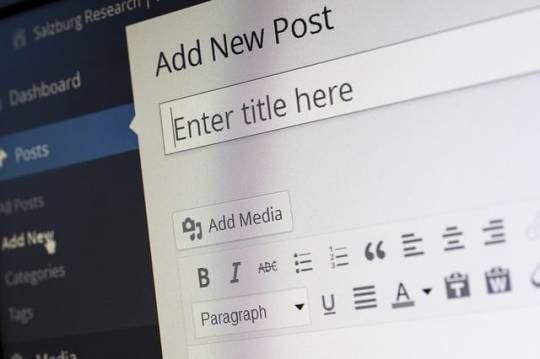
How I Write My Blog Posts
You may be wondering how I write my blog posts. It's a process that generally follows the same path, though sometimes outside influences may change the path a bit.
In this post I’ll take you through my process. You may find it helpful, but remember it's never about the process. Your approach may be different than mine, but that's OK. Do what works for you.
What you always have to remember is that your audience wants to be informed and educated. Keep your posts interesting and provide information on topics that are of current interest and timely .
This doesn’t apply to just blog posts. You could use the same process for creating your other web content including your YouTube videos or podcast episodes.
My First Step is Pretty Logical, I Select a Topic
I'm presently writing three blogs. The Better Business Alliance is my main blog, however I also address two topics with my other blogs that are also important to me.
Accessibility International and Sustainability International are written to address two topics that should matter to all of us. The topics of Accessibility and Sustainability are important and affect all of our lives.
The topics I choose to blog about in each blog are either points that are of particular interest to me, or need to be discussed because of their importance for all of us.
My Better Business Alliance blog is mainly focused on helping business owners develop a Digital Marketing Strategy to help them grow their business. Digital Marketing may seem to be an overwhelming task for most small business owners. It's not, if you approach it by breaking it down into a number of related steps for successfully marketing your business.
My blogs teach people how to do things. The majority of my posts are “how to” content. If you have a different style of blog, you may follow a different path for developing your post topics.
Consider the Needs of Your Readers
While many of my topics come out of readers’ questions or problems, sometimes I just write about something that I feel will help and inform the reader. It's important at this step and take a moment to think about my reader’s situation. I will write a couple of sentences about who I'm trying to reach and how they may view the topic that I have decided to write about.
By putting myself in the reader's mindset, I am better able to write with empathy and write a post that is truly relevant to my reader. It's also important to consider what the reader will do after reading the post.
If I'm writing about a problem, I might wonder if my reader's have the same problem. How would they feel about the problem? What have they tried to help them solve the problem? What has stopped them from solving the problem in the past? How can my post help them solve their problem?
Before you even begin writing, you should think about what your call to action will be. This will shape the headline, your introduction, how you compose your post's body, and how you reach your conclusion.
Create Your Working Title
Once I have selected my topic and considered how I want to approach my reader's perspective, I like to come up with a working title.
Creating my working title often helps me develop a unique angle for the post. If I'm working on an idea for my Accessibility International blog, I may want to help my readers better understand the need for alternative text.
Most of my reader's may have some grasp of what alternative text is. However, the correct use of alternative text in the many different situations where it is appropriate and necessary are very diverse and sometimes difficult to understand. Communicating the uses in a cogent and correctly worded titl is an important step for writing the blog post and telling what your reader's need to know.
It's important to keep in mind that this is just a working title. After completing the post, I will revisit my title choice and tweak it. Occasionally, it will be changed several times, til I have the title for my post that best expresses what I am trying to communicate to my readers.
Outline Your Post
This is when I list the main points I want to teach someone in my post. It doesn't require a lot of writing here. It's normally just the main points in a Word document on my computer. During this process I am examining the identified problem, brainstorming answers to the questions and solutions for the problem.
This involves outlining the steps a reader must follow to solve their problem or master a new skill. It's like building the skeleton of your post, where you will add the muscle at a later time. Many of the bullet points which I have created often become subheadings in my completed post.
By developing the main sections and then the subheadings for each section, your post begins to take shape. Many times I will have more points than I'll use in my finished post. I'll begin to remove the weaker or less relevant points which allows me to focus on the more important things that I want to say.
Now I'll take a little time to arrange the remaining points into the most logical order. Many bloggers seem to skip this step. But sorting your information into a logical order is a very important step. You need the points you cover to each build on the information provided by the preceding section. This will make a noticeable difference to the readability and quality of your finished post.
Critique Your Outline
With your outline finished, it's a good time to ask some questions you may have about your developing post. Will my readers find my post informative and useful? Will readers have a positive reaction when they read it, or will they just think it is okay? Is it groundbreaking, will it change reader's lives in any way? After people finish reading the post will they still have questions?
Now is the time to ask these questions. Instead of waiting until you have finished writing the entire post. Then if you find that there are possible gaps or weak ideas in your post, you can take the time to do the additional research which may be required.
Write the Introduction
Some bloggers write their post and then write the introduction. However writing the introduction first often works best for me. It helps me establish the proper tone for my post and allows me to get into the mindset adapting to the natural flow of writing my post.
Much like the working title, the introduction often shapes the direction of the post. My introduction is usually one to three paragraphs long. But again like the working title, I go back to edit the introduction after finishing the post.
As you write the introduction, consider your reader and their situation, question or problem. Show them you really understand how they feel.
If you can show some empathy in the first few lines of your post, you’ll make a deeper connection with your reader. And they’ll want to read the rest of your article.
This is also a good point to paint a picture of how the reader will benefit from reading your post. What will they be able to achieve after reading it?
Expand on the Main Points
With your outline written, it's time to write more on each point to create the main part of your content. You just give each of your points the additional content and facts beyond what you’ve already written.
Keep your reader in mind while you write. What problem are they trying to solve? As they read your post, imagine what they are wondering about at different points in your post? Will they be confused while they read? You want to ensure that your post makes sense and does what is intended.
By now it’s probably clear that I write my posts in the order that people will read them. I begin with the working title, then the introduction and move on to writing the body of the post. This works best for me, however you'll have to adjust and do what works best for you.
Write the Conclusion and Your Call to Action
Writing a great blog posts requires that it also must come to a conclusion. I create this after writing the main part of my post, and it's a matter of recapping what I've taught readers during the rest of the post.
I’ll restate the problem or question I set out in the introduction, and remind people what I’ve tried to teach them. I’ll also summarize the main points to refresh the readers memory. It’s then really important to give readers something specific to take action on.
Go back to whatever you identified as your reader's need, and clearly state what you want them to do next. My call to action might be encouraging them to try out the technique they’ve just learned, or to leave a comment or interact in some way.
Don’t give them several different things to do here. And make sure your call to action flows from the goals of your blog and this particular post.
Add Depth and Appeal to the Post
At this stage of the process, I look for things I could add to make a post even better. I might want to include a story or anecdote which would add to what I have written. Or I might add an image or embed a video that would add relevance to my post. Charts and graphics could illustrate a key point in your post, making it easier to understand.
You could even add a quote or an interview that would add another perspective to your post to lend it further credibility. This is about making the post better, and ensuring that it looks good and has plenty of visual interest.
Edit and Proofread the Post
With this final step, it’s important to go over your post one final time to make sure you haven’t made any mistakes or typos. Allowing some time between when I write and when I edit is also important. I feel that we use different parts of our brains for critical thinking and editing.
You don't want to waste all your hard work by publishing a post that’s riddled with errors and mistakes. Quality control matters, so make sure you have sufficient time to edit and proofread.
You could also get someone else in to help you at this stage of the process. It could be a fellow blogger who you swap posts with, or a professional editor or proofreader.
Visit Our Web Accessibility BlogVisit Our Business Sustainability Blog
A Quick Summary of My Process
Here’s a quick recap of my blog post writing process from start to finish:
Select a topic
Consider the Needs of Your Readers
Create Your Working Title
Outline Your Post
Critique Your Outline
Write the Introduction
Expand on the Main Points
Write the Conclusion and Your Call to Action
Add Depth and Appeal to the Post
Edit and Proofread the Post
That’s my workflow. Perhaps you have an extra step, or do things in a different order. Feel free to share your thoughts in the comments.
Develop Your Own Workflow
Regardless of your workflow, it’s important to pause along the way and be consider the process. Keep thinking about who’s reading your content. The reader with the questions, problems and feelings. If you can show you understand them, you’ll create a real sense of connection.
So don’t just think about creating content. Think about crafting it, and taking care and time to make it the best it can be.
Read the full article
#BetterBusinessAlliance#blog#blogpost#blogger#Blogging#clickthrough#contentmarketing#customerengagement#customerexperience#digitalmarketing#Digitalmarketingstrategy#reputation#SEO#socialmedia#socialmediamarketing#userexperience
0 notes